The Australian Maritime Safety Authority makes this heritage management plan under section 341S of the Environment Protection and Biodiversity Conservation Act 1999 (Cth) for Cape Wickham Lighthouse.
20 May 2022
Mick Kinley
Chief Executive Officer
Copyright
© Australian Maritime Safety Authority
The Australian Maritime Safety Authority encourages the dissemination and exchange of information provided in this publication.
Except as otherwise specified, all material presented in this publication is provided under Creative Commons Attribution 4.0 International licence. This excludes:
- the Commonwealth Coat of Arms
- this department's logo
- content supplied by third parties.
The Creative Commons Attribution 4.0 International Licence is a standard form licence agreement that allows you to copy, distribute, transmit and adapt this publication provided that you attribute the work. The details of the version 4.0 of the licence are available on the Creative Commons website, as is the full legal code for that licence.
Third Party Copyright
Some material in this document, made available under the Creative Commons Licence framework, may be derived from material supplied by third parties. The Australian Maritime Safety Authority has made all reasonable efforts to identify content supplied by third parties using the following format ‘© [name of third party]’ or ‘Source: [name of third party]’. Permission may need to be obtained from third parties to re-use their material.
Acknowledgements
The Australian Maritime Safety Authority acknowledges the Traditional Custodians of country throughout Australia and their connections to land, sea and community.
Contact
For additional information or any enquiries about this heritage management plan, please contact:
The Australian Maritime Safety Authority,
Manager Asset Management and
Preparedness,
PO Box 10790,
Adelaide Street, Brisbane QLD 4000
Phone: (02) 6279 5000 (switchboard)
Email: Heritage@amsa.gov.au
Website: www.amsa.gov.au
Attribution
AMSA’s preference is that you attribute this publication (and any material sourced from it) using the following wording:
Source: Australian Maritime Safety Authority Cape Wickham Lighthouse Heritage Management Plan – 2022
Front cover image
Figure 1. Cover photo of Cape Wickham lighthouse ( ©AMSA, 2018)
More information
For enquiries regarding copyright including requests to use material in a way that is beyond the scope of the terms of use that apply to it, please contact us through our website: www.amsa.gov.au

Cape Wickham Lighthouse
Heritage Management Plan
2022
Table of Contents
- Introduction
- Background and purpose
- Heritage management plan objectives
- Methodology
- Status
- Authorship
- Acknowledgements
- Language
- Previous reports
- Sources of information and images
2. Cape Wickham Lightstation site
2.1 Location
2.2 Setting and landscape
2.3 Lease and ownership
2.4 Access
2.5 Listings
3. History
3.1 General history of lighthouses in Australia
3.2 Tasmanian Lighthouse Administration
3.3 King Island: a history
3.4 Building a lighthouse
3.5 Lighthouse keeping
3.6 Chronology of major events
3.7 Changes and conservation over time
3.8 Summary of current and former uses
3.9 Summary of past and present community associations
3.10 Unresolved questions or historical conflicts
3.11 Recommendations for further research
4. Fabric register
4.1 Register
4.2 Related object and associated AMSA artefact
4.3 Comparative analysis
5. Heritage significance
5.1 Commonwealth heritage listing – Cape Wickham Lighthouse
5.2 Tasmanian State heritage register – Cape Wickham Lighthouse
5.3 Condition and integrity of the Commonwealth heritage values
5.4 Gain/loss of heritage values
6. Opportunities and constraints
6.1 Implications arising from significance
6.2 Framework: sensitivity to change
6.3 Statutory and legislative requirements
6.4 Operational requirements
6.5 Occupier needs
6.6 Proposals for change
6.7 Potential pressures
6.8 Process for decision-making
7. Conservation management principles and policies
7.1 Policies
8. Policy implementation plan
8.1 Plan and schedule
8.2 Monitoring and reporting
9. Appendices
Appendix 1. Glossary of heritage conservation terms
Appendix 2. Glossary of historic lighthouse terms relevant to Cape Wickham
Appendix 3. Cape Wickham current light details
Appendix 4. Table demonstrating compliance with the EPBC Regulations
Reference list
Endnotes
List of Figures
Figure 1. Cover photo of Cape Wickham Lighthouse (© AMSA, 2018)
Figure 2. Planning process applied for heritage management (Source: ICOMOS Australia, 1999)
Figure 3. View of King Island within Bass Strait (Map data ©2021 Google, TerraMetrics)
Figure 4. View of King Island coastline from Cape Wickham Lighthouse tower (© AMSA, 2017)
Figure 5. Cape Wickham AMSA map of lease (Map data: Esri, DigitalGlobe, GeoEye, Earthstar Geographics, CNES/Airbus DS, USDA, USGS, AeroGRID, IGN, GIS User Community)
Figure 6. View of surrounding rural landscape from Cape Wickham Lighthouse tower (© AMSA, 2017)
Figure 7. Incandescent oil vapour lamp by Chance Brothers (Source: AMSA)
Figure 8. Dioptric lens on display at Narooma (Source: AMSA)
Figure 9. Dalén’s system – sun valve, mixer and flasher (Source: AMSA)
Figure 10. Blueprints for Cape Wickham lantern house, c.1861 Image courtesy of the National Archives of Australia. NAA: A9568, 5/4/1 (© Commonwealth of Australia, National Archives of Australia)
Figure 11. Blueprint of Cape Wickham Lighthouse tower, 1861. Image courtesy of the National Archives of Australia. NAA: A10182, CN 01 131 (© Commonwealth of Australia, National Archives of Australia)
Figure 12. Cape Wickham Lightstation prior to demolition of cottages, 1917. Image courtesy of the National Archives of Australia. NAA: A6247, B10/2. (© Commonwealth of Australia, National Archives of Australia)
Figure 13. Design for Cape Wickham’s conversion to automatic operation, 1918. Image courtesy of the National Archives of Australia. NAA: A9568, 5/4/3 (© Commonwealth of Australia, National Archives of Australia)
Figure 14. Cape Wickham Lighthouse balcony replacement blueprints, 1918. Image courtesy of the National Archives of Australia. NAA: A10182, CN 01 133 (© Commonwealth of Australia, National Archives of Australia)
Figure 15. 150th anniversary opening, Cape Wickham Lighthouse (Source: AMSA, 2011)
Figure 16. From left to right: Swan Island Lighthouse (1845), Goose Island Lighthouse (1846), and Cape Wickham Lighthouse (1861) (Source: AMSA)
Executive summary
Cape Wickham Lighthouse is a historic site recognised by both Commonwealth and State Governments for its heritage significance. The lighthouse was placed on the Commonwealth Heritage List in 2004 for its contribution to the network of lighthouses established in Bass Strait in the 19th century. It is renowned as the tallest Australian lighthouse, for its aesthetic appeal in the rural landscape, and for the retention of its original Wilkins & Co lantern house and timber staircase.
Cape Wickham Lighthouse was placed on the Tasmanian heritage register for its historical, informative and aesthetic significance, in addition to its significant rarity and community associations.
Situated on the northern shore of King Island (Tas), the lighthouse overlooks Bass Strait, a treacherous stretch of water which separates the Australian State of Tasmania from the mainland. Built in 1861, the lighthouse was constructed to increase safety within Bass Strait following the boom of coastal shipping along the mainland’s south-east corner. The masonry tower was designed by Tasmanian-based engineer, WB Falconer, and the lightstation originally comprised of a tower, three keeper residences, and a superintendent’s house.
Although the Cape Wickham Lighthouse orignally housed a 1st Order Chance Bros catadioptric lens, the tower now exhibits a light-emitting diode (LED) source through a 1946 Chance Bros six panel catadioptric lens. The light now runs on an automated mechanism as part of AMSA’s network of Aids to Navigation (AtoN). The equipment is serviced by the Australian Maritime Safety Authority’s (AMSA) maintenance contractor who visits at least once each year. AMSA officers visit on an ad hoc basis for auditing, projects and community liaison purposes.
The larger part of the lightstation lies outside of the AMSA lease and is managed by Tasmanian Parks and Wildlife Service (TAS PWS). Although visitors are able to access the site, the light tower maintains restricted access.
This heritage management plan is concerned mainly with the lighthouse tower, but also addresses the management of the surrounding precinct and land. The plan is intended to guide decisions and actions. This plan has been prepared to integrate the heritage values of the lighthouse in accordance with the Environment Protection and Biodiversity Conservation Act 1999 (Cth) (EPBC Act) and the Environment Protection and Biodiversity Conservation Regulations 2000 (Cth) (EPBC Regulations).
Well-built and generally well-maintained, Cape Wickham Lighthouse precinct is in relatively good, stable condition. The policies and management guidelines set out in this heritage management plan strive to ensure that the Commonwealth heritage values of the Cape Wickham Lighthouse are recognised, maintained, and preserved for future generations.

- Introduction
1.1 Background and purpose
The Australian Maritime Safety Authority (AMSA) is the Commonwealth agency responsible for coastal AtoN. AMSA’s network includes Cape Wickham Lighthouse built in 1861.
- a description of the place, its heritage values, their condition and the method used to assess its significance
- an administrative management framework
- a description of any proposals for change
- an array of conservation policies that protect and manage the place
- an implementation plan
- ways the policies will be monitored and how the management plan will be reviewed.
AMSA has prepared this heritage management plan to guide the future conservation of the place. This plan provides the framework and basis for the conservation and best practice management of Cape Wickham Lighthouse in recognition of its heritage values. The policies in this plan indicate the objectives for identification, protection, conservation and presentation of the Commonwealth heritage values of the place. Figure 2 shows the basic planning process applied.

Figure 2. Planning process applied for heritage management (Source: Australia ICOMOS, 1999)
1.2 Heritage management plan objectives
The objectives of this heritage management plan are to:
- protect, conserve and manage the Commonwealth heritage values of Cape Wickham Lighthouse
- interpret and promote the Commonwealth heritage values of Cape Wickham Lighthouse
- manage use of the lighthouse
- use best practice standards, including ongoing technical and community input, and apply best available knowledge and expertise when considering actions likely to have a substantial impact on Commonwealth heritage values.
In undertaking these objectives, this plan aims to:
- Provide for the protection and conservation of the heritage values of the place while minimising any impacts on the environment by applying the relevant environmental management requirements in a manner consistent with Commonwealth heritage management principles.
- Take into account the significance of King Island as a cultural landscape to Aboriginal people over many thousands of years.
- Recognise that the site has been occupied by lease holders since the early 20th century.
- Encourage site use compatible with the historical fabric, infrastructure and general environment.
- Record and document maintenance works, and changes to the fabric, in the Cape Wickham Lighthouse fabric register (see 4.1 Fabric).
The organisational planning cycle and associated budgeting process is used to confirm requirements, allocate funding and manage delivery of maintenance activities. Detailed planning for the AtoN network is managed through AMSA’s internal planning processes.
An interactive map showing many of AMSA’s heritage sites, including Cape Wickham Lighthouse, can be found on AMSA’s Interactive Lighthouse Map[1].
1.3 Methodology
- details a history of the site based on information sourced from archival research, expert knowledge, and documentary resources,
- provides a description of the site based on information sourced from site inspection reports and fabric registers, and;
- details the Commonwealth heritage criteria satisfied by Cape Wickham Lighthouse as set out by schedule 7A of the EPBC Regulations.
The criterion set out at Schedule 7A (h) (i-xiii) informed the development of the required policies for the management of Cape Wickham Lighthouse, in conjunction with input from the Department of Agriculture, Water and the Environment on best practice management.
Consultation
AMSA also consulted with Aboriginal Heritage Tasmania (Department of Primary Industries, Parks, Water and Environment, Tas) and were provided with information on Aboriginal heritage in the vicinity of the lighthouse. This information was included in the plan.
In preparation of the plan, AMSA consulted with TAS PWS who provided valuable information and feedback on land management. This information was included within the plan.
The draft management plan was advertised in accordance with the EPBC Act and the EPBC Regulations. On the 22 December 2021 a notice was placed in The Australian newspaper publication which invited the general public to review the draft plan and provide feedback. Public consultation closed on the 20 January 2022. No submissions were received from the general public.
AMSA submitted the draft plan to the Heritage Branch of the Department of Agriculture, Water and the Environment who provided feedback on the draft. These comments were incorporated into the final document. A developed draft was submitted to the Federal Minister through the Heritage Branch and in that process the Minister’s delegate sought advice from the Australian Heritage Council. On 14 April 2022, the Minister’s delegate determined that the plan satisfied the requirements of the EPBC Act.
1.4 Status
1.5 Authorship
This plan has been prepared by AMSA. At the initial time of publication, Australian Maritime Systems Group (AMSG) is the contract maintenance provider for the Commonwealth Government’s AtoN network including Cape Wickham Lighthouse.
1.6 Acknowledgements
1.7 Language
For clarity and consistency, some words in this plan such as restoration, reconstruction and preservation, are used with the meanings defined in the Illustrated Burra Charter[2]. See Appendix 1 ‘Glossary of heritage conservation terms’. Also see Appendix 2 ‘Glossary of lighthouse
terminology’ which sets out the technical terminology used in this plan.
1.8 Previous reports
A Heritage Site Report was produced by the Australian Construction Services – Heritage and Environment Group, for AMSA in September 1993.[3]
A Heritage Lighthouse Report was produced by heritage architect consultant, Peter Marquis-Kyle, for AMSA in 2007.[4]
1.9 Sources of information and images
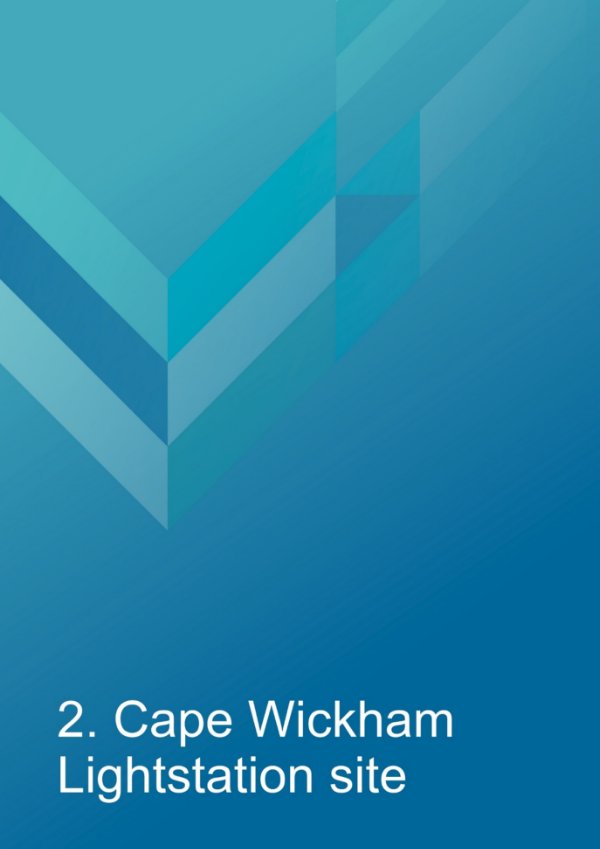
2. Cape Wickham Lightstation site
2.1 Location
The Cape Wickham Lighthouse is located on King Island, a 1,098 kilometre-squared island found within Bass Strait nestled between the Australian state of Tasmania and the mainland. Situated approximately nine kilometres north-north-west of Egg Lagoon, Cape Wickham Lighthouse stands on the northern tip of the Island.
Coordinates: 39º 35.3060’S, 143º 56.5830’E.
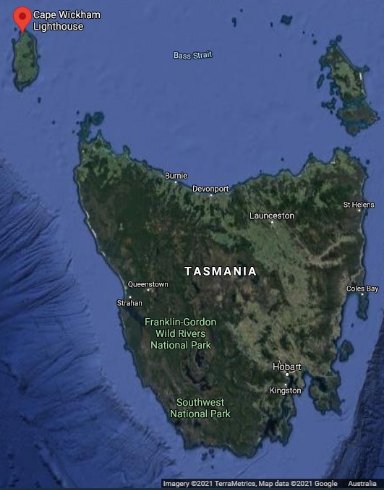
 Figure 3. View of King Island within Bass Strait (Map data: ©2021 Google, TerraMetrics)
Figure 3. View of King Island within Bass Strait (Map data: ©2021 Google, TerraMetrics)
2.2 Setting and landscape
As the second largest island in the Bass Strait, King Island is a predominantly rural land mass subject to the Roaring Forties, strong westerly winds found across the southern hemisphere. With a relatively flat topography, the island features a combination of sand dunes along the western coastline, and steep rocky cliffs along the eastern and southern coastline.
The Cape Wickham Lighthouse, situated along the northern point of King Island, is surrounded by open, rural plains and a golf course. The tower is located within Cape Wickham State Reserve which is managed by the Tasmanian Parks and Wildlife Service.
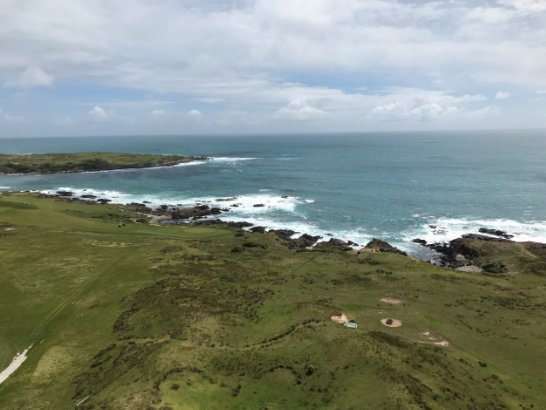
Figure 4. View of coastline from Cape Wickham lighthouse tower (© AMSA, 2017)
Fauna and flora
King Island maintains a range of fauna and flora, somewhat limited by the island’s geographic isolation. With an estimated 28 native vegetation communities, six communities are listed as ‘threatened’. These include:
- coastal complex
- Eucalyptus brookeriana
- Eucalyptus globulus
- Melaleuca ericifolia
- seabird rockery complex
- wetlands
Fifty flora species on the island have been registered and include:
- Hedycarya angustifolia (Australian mulberry)
- Elaeocarpus reticulatus (blueberry ash)
- Pimelea axiflora (bootlace bush)
The island maintains a diverse range of fauna including:
- six fish species
- six frog species
- nine reptile species
- 164 bird species
- 12 mammal species
Due to the strong bird population, specific areas have been identified on the Island as Important Bird Areas. The Lavinia State Reserve located to the north-east is recognised as a habitat for the critically endangered orange-bellied parrot (Neophema chrysogaster) along their migration route.
A biodiversity management plan for King Island was implemented in 2012. This plan can be accessed publicly via the Department of Agriculture, Water and the Environment website.[5]
2.3 Lease and ownership
AMSA holds a lease for the lighthouse and land from the Minister administering the National Parks and Wildlife Act 1970 (Tas). The lease is currently administered through TAS PWS.
The AMSA lease consists of two parcels of land:
- lot 1 (1964 metres-squared)
- lot 2: lighthouse tower (780 metres-squared)
The current lease was signed on 1 May 1998 for a period of 25 years, with the option to renew for a period of 25 years.

Figure 5. Cape Wickham AMSA map of lease (Map data: Esri, DigitalGlobe, GeoEye, Earthstar Geographics, CNES/Airbus DS, USDA, USGS, AeroGRID, IGN, GIS User Community)
2.4 Access
Cape Wickham Lighthouse can be accessed by vehicle via Cape Wickham Road with open pedestrian access available from all directions of the lighthouse tower. Access inside the lighthouse is restricted to authorised personnel only.

Figure 6. View of surrounding rural landscape from Cape Wickham lighthouse tower (© AMSA, 2011)
2.5 Listings
Cape Wickham Lighthouse is listed on the following heritage registers:
Register | Place ID |
Commonwealth Heritage List | 105567[6]
|
Tasmanian Heritage Register | 3613[7]
|
Register of the National Estate (non-statutory archive) | 102874[8]
|

3. History
3.1 General history of lighthouses in Australia
The following century oversaw the construction of hundreds of lighthouses around the country. Constructing and maintaining a lighthouse were costly ventures that often required the financial support of multiple colonies. However, they were deemed necessary aids in assisting the safety of mariners at sea. Lighthouses were firstly managed by the colony they lay within, with each colony developing their own style of lighthouse and operational system. Following Federation in 1901, which saw the various colonies unite under one Commonwealth government, lighthouse management was transferred from state hands to the Commonwealth Lighthouse Service.
Lamps and optics: an overview
Lighthouse technology has altered drastically over the centuries. Eighteenth century lighthouses were lit using parabolic mirrors and oil lamps. Documentation of early examples of parabolic mirrors in the United Kingdom, circa 1760, were documented as consisting of wood and lined with pieces of looking glass or plates of tin. As described by Searle, ’When light hits a shiny surface, it is reflected at an angle equal to that at which it hit. With a light source is placed in the focal point of a parabolic reflector, the light rays are reflected parallel to one another, producing a concentrated beam’. [9]
Figure 7. Incandescent oil vapour lamp by Chance Brothers (Source: AMSA)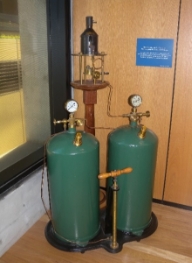
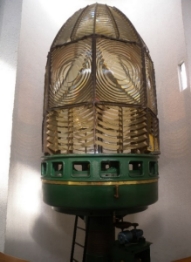 Figure 8. Dioptric lens on display at Narooma (Source: AMSA)
Figure 8. Dioptric lens on display at Narooma (Source: AMSA)
Early Australian lighthouses were originally fuelled by whale oil and burned in Argand lamps, and multiple wicks were required in order to create a large flame that could be observed from sea. By the 1850s, whale oil had been replaced by colza oil, which was in turn replaced by kerosene, a mineral oil.
In 1900, incandescent burners were introduced. This saw the burning of fuel inside an incandescent mantle, which produced a brighter light with less fuel within a smaller volume. Light keepers were required to maintain pressure to the burner by manually pumping a handle as can be seen in Figure 7.
In 1912, Swedish engineer Gustaf Dalén, was awarded the Nobel Prize in physics for a series of inventions relating to acetylene-powered navigation lights. Dalén’s system included the sun valve, the mixer, the flasher, and the cylinder containing compressed acetylene. Due to their efficiency and reliability, Dalén’s inventions led to the gradual demanning of lighthouses. Acetylene was quickly adopted by the Commonwealth Lighthouse Service from 1915 onwards.
Large dioptric lenses, such as that shown in Figure 9, gradually decreased in popularity due to cost and the move towards de-staffed automatic lighthouses. By the early 1900s, Australia had stopped ordering these lenses with the last installed at Eclipse Island in Western Australia in 1927. Smaller Fresnel lenses continued to be produced and installed until the 1970s when plastic lanterns, still utilising Fresnel’s technology, were favoured instead. Acetylene remained in use until it was finally phased out in the 1990s.
In the current day, Australian lighthouses are lit and extinguished automatically using mains power, diesel generators, and solar-voltaic systems.

Figure 9. Dalén's system - sunvalve, mixer, and flasher (Source: AMSA)
The Commonwealth Lighthouse Service
When the Australian colonies federated in 1901, they decided the new Commonwealth Government would be responsible for coastal lighthouses. This included major lights used by vessels travelling from port to port, not the minor lights used for navigation within harbours and rivers. There was a delay before this new arrangement came into effect and existing lights continued to be operated by the states.
Since 1915, various Commonwealth departments have managed lighthouses. AMSA, established under the Australian Maritime Safety Authority Act 1990 (Cth), is now responsible for operating Commonwealth lighthouses and other aids to navigation, along with its other functions.
3.2 Tasmanian Lighthouse Administration
The table below outlines the timeline for Tasmanian lighthouse management.
Time Period | Administration |
1915 – 1927
1927 – 1963
1963 – 1972
1972 – 1982
1982 – 1983
1983 – 1985
1985 – 1987
1987 – 1990
1991 --
| Lighthouse District No 3. (Victoria, New South Wales, Tasmania), Hobart Headquarters.
Deputy Director of Lighthouses and Navigation, Tasmania.
Department of Shipping and Transport, Regional Controller, Tasmania.
Department of Transport [III], Regional Controller, Tasmania.
Department of Transport and Construction. Victoria-Tasmania Region, Transport Division (Tasmania)
Department of Transport [IV] Victoria-Tasmania Region, Hobart Office.
Department of Transport [IV], Tasmanian Region.
Department of Transport and Communications, Tasmanian Region.
Australian Maritime Safety Authority.
|
3.3 King Island: a history
Aboriginal history
The Office of Aboriginal Affairs (Tas) advised that although Aboriginal people did visit King Island, there was no permanent inhabitation of the island. Numerous Aboriginal heritage sites were recorded in the Victoria Cove area and around Lake Wickham on the island.
Further information from the Aboriginal Land Council of Tasmania will be included in this section in future updates of the plan.
Early European history
In 1798, the passage of water separating Tasmania from the mainland was charted by British explorer George Bass, and British navigator and cartographer Matthew Flinders. Named ‘Bass Strait’, this passage was traversed by countless ships that had previously been forced to journey around the south coast of Tasmania. However, the maps of the Strait Flinders created and sent back to England in 1800 did not include King Island. In 1799, Captain Reed sighted King Island while on a seal hunting expedition aboard the schooner Martha. Reed informed Flinders of the Island’s existence and in Flinders’ second map of the Strait made mention of a “Land of considerable extent”.[10]
Following Reed’s sighting, British Privateer, Captain John Black, visited the island and named the island after New South Wales governor Phillip Gidley King. In that same trip, Black named Harbinger Rocks, located off the island’s north-west coast, after his ship Harbinger. It was here that an abundance of fur seals and Southern elephant seals were found – the seals were exploited into extinction shortly thereafter.[11]
Governor King, concerned the French navigator Nicolas Baudin was en route to claim the island for France, ordered the ship Cumberland to sail from Sydney in 1800 and claim the land for Britain. Despite failing to claim the land for France, Baudin circumnavigated and mapped the island in 1802.[12]
Hunting remained the primary practice on the island throughout the early 19th century. By 1854, the island had emptied of inhabitants save for the occasional visitors who scoured the land for any remaining seals and wallabies. In 1859, a communications cable was erected across the Bass Strait connecting King Island to Cape Otway in Victoria, and Stanley Head on the Tasmanian mainland.
By the 1880s, the land on King Island was officially opened for grazing and the township of Currie, located along the west coast, developed shortly thereafter.
3.4 Building a lighthouse
Why Cape Wickham?
The Bass Strait passage was notorious for the number of lives lost in its waters following European settlement in the region. An estimated 60 vessels and over 600 lives were claimed within the passage, significantly from the wrecks of the Neva in 1835 and the Cataraque in 1845.[13]
In 1841, the first recommendation for the lighting of the Bass Strait was made by the governor of Van Diemen’s Land, John Franklin. Franklin initially proposed the erection of a lighthouse on the northern coast of King Island and, in 1846, a Select Committee on Light Houses supported this recommendation. The following year however, King Island as a site was dismissed as some voiced concerns that a light on King Island would draw vessels onto Harbinger Reefs – a submerged collection of reefs located several miles west of the Island. Instead, favour was diverted to the construction of a light at Cape Otway along the Victorian coastline.[14]
Despite the construction of a new light on Cape Otway, Bass Strait continued to claim lives over the following years. Between the years of 1854 and 1856, no less than six ships were lost in the waters around King Island – occurrences that propelled plans for a Cape Wickham Lighthouse to the forefront. At the Joint Colonial Lighthouse Conference of 1856, it was decided that a lighthouse would be constructed on Cape Wickham, and that it would be built and maintained by Tasmania, Victoria and New South Wales.[15]
Design
Tasmanian-based engineer W B Falconer was chosen to design the light for Cape Wickham. Upon attempting to visit the Island in 1858 for a site inspection, the whaleboat carrying Falconer overturned and a fellow traveller was drowned. Falconer managed to pull himself to safety and went on to inspect the proposed lighthouse site.[16]
Following this visit, Falconer produced two differing tower designs – one masonry tower at an estimated cost of £19,507, and a pre-fabricated cast iron tower at an estimated cost of £23,743. The masonry tower design was eventually chosen for the site.[17]
In order for the light to be visible in an arc from south-south-west to east-south-east at a distance of 37 kilometres, it was reccomended that the tower be 100 metres above high water mark. Owing to the selected Cape Wickham site being a ridge 52 metres above sea level, it was calculated that the tower needed to be 48 metres in height.[18]
Construction and equipment when built
Following the acceptance of a design, tenders for the construction of Cape Wickham Lighthouse were called in November 1859. The successful contractors were Kirkland and Co. of Melbourne, and construction started shortly thereafter.[19]
By 1860, two thousand tons of granite had been quarried on King Island and transported via tramway to the chosen site. By October of the same year, the foundations for the tower had been laid. The masonry tower was complete by 4 June 1861, and the lantern and apparatus arrived on King Island shortly thereafter.
Following its completion in 1861, the Cape Wickham Lighthouse stood at 158 feet (48 metres) with 11 flights of wooden stairs. The lantern room housed a large Wilkins and Co. single-wick
lamp which shone through a 1st Order Chance Bros. catadioptric lens and powered by sperm whale oil (intensity: 7,500 candlepower). The tower, which came to a final cost of £18,281, was also accompanied by three keeper residences and a superintendent’s house (these buildings were later demolished circa. 1921).[20] The light was first exhibited on 1 November 1861, however the lighthouse was never officially opened.

Figure 10. Blueprints for Cape Wickham lantern house, c. 1861 Image courtesy of the National Archives of Australia. NAA: A9568, 5/4/1 (© Commonwealth of Australia, National Archives of Australia)

Figure 11. Blueprint of Cape Wickham Lighthouse tower, 1861. Image courtesy of the National Archives of Australia. NAA: A10182, CN 01 131 (© Commonwealth of Australia, National Archives of Australia)
3.5 Lighthouse keeping
Presided over by a superintendent and three assistants, the Cape Wickham Lighthouse was staffed from its construction in 1861 until 1921. Captain Duigan was the first superintendent stationed at the light, followed by Edward Nash Spong in 1862 who was stationed at Cape Wickham for 30 years.
With open settlement on the island strictly forbidden until the 1880s, life at the Cape Wickham Lightstation was increasingly isolated. Fishermen and sealers were the mere few that visited the island albeit irregularly. It wasn’t until the construction of a light at Currie (1879) on the west coast of the island that a permanent population was established.[21]
Following the installation of an automatic acetylene flasher, the need for a superintendent and assistants onsite was no longer necessary, and the cottages were demolished in 1921.[22]
3.6 Chronology of major events
Listed below are the major events related to the Cape Wickham Lighthouse.
Date | Event |
1 Nov 1861 | Light first exhibited from Cape Wickham Lighthouse.
|
Circa 1880s | King Island opened for settlement (farming and grazing). The township of Currie is established.
|
17 May 1898 | Lighthouse struck by lightning – ground floor of tower ‘pierced’ by strike. Assistant lightkeeper shocked and knocked unconscious.[23]
|
13 July 1918-1921 | Lighthouse converted to automated operation and de-staffed. Original balcony replaced and keepers’ cottages demolished.[24]
|
1939-1941 | Radio beacon established at Cape Wickham.[25]
|
1965 | New generator room built.
|
1988-1989 | Radio beacon discontinued.
|
Nov 2011 | Lighthouse ‘officially’ opened by former Governor-General Quentin Bryce.
|
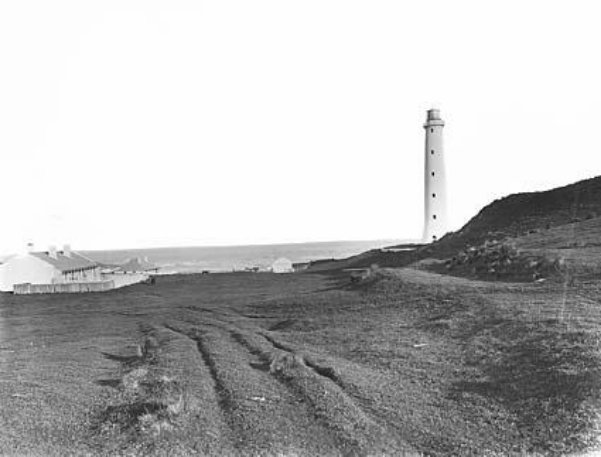
Figure 12. Cape Wickham Lightstation prior to demolition of cottages, 1917. Image courtesy of the National Archives of Australia. NAA: A6247, B10/2 (© Commonwealth of Australia, National Archives of Australia)
3.7 Changes and conservation over time
Owing to alterations in lighthouse fabric and technology over the course of the 19th, 20th and 21st centuries, Cape Wickham Lighthouse has undergone a number of changes.
The Brewis Report
Commander CRW Brewis, retired naval surveyor was commissioned in 1911 by the Commonwealth Government to report on the condition of existing lights and to recommend any additional ones. Brewis visited every lighthouse in Australia between June and December 1912 and produced a series of reports published in their final form in March 1913. These reports were the basis for future decisions made in relation to the towers’ capabilities.[26]
The recommendations made for the Cape Wickham Light included:
- discontinuing the signal station
- changing the light’s character from fixed to occulting
- installing an 85mm incandescent mantle, and increasing the light’s power to 35,000 candlepower.
Cape Wickham (King Island). (22 miles from Currie Harbour, by road.) Lat. 39º 36’ S., Long. 143º 57’ E., Chart No. 404.- Established in the year 1861. Lloyd’s Signal Station. Not connected by telephone. Character.- One white, fixed apparatus, 1st Order, dioptric. Candle-power, 7500. Granite tower, 145 feet. Height of focal plane, 280 feet above high water. Visible, in clear weather, 24 nautical miles, from N. 22º E., through east, to N. 76º W. Condition and State of Efficiency.- The light is situated 22 miles by road from Currie Harbour, the township of King Island. There are farms near the light-house so the position is not isolated. The light-house, tower, and apparatus are in a good state of preservation. The dwellings require repairs, and renewals to fences are necessary. Three light-keepers are stationed here. RECOMMENDED.- (a) As reefs extend for a distance of 4 ½ miles to seaward, the tides being very treacherous, setting strongly towards King Island, the Signal Station be discontinued. Vessels should give this locality a wide berth and not be encouraged to approach within signalling distance. Caution.- Extract from the Admiralty Sailing Directions, Australia, Vol. I., page 410, referring to the Report by the Light-house Commissioners appointed by the State Government in the year 1859:- “In advising the erection of a light-house in the neighbourhood of Cape Wickham, the Commissioners wish to guard themselves from affording the public any reasonable supposition that this light can be at all considered in a position of a great highway light for the navigation of Bass Strait; and the light at Cape Wickham can only be regarded as a beacon warning navigators of danger, rather than a leading light to a great thoroughfare.” (b) The light be given a distinctive character, by inserting an occulting screen, actuated by clockwork mechanisms (to be wound every sixteen hours), thus converting the light from fixed to occulting. Light characteristic – occulting every five seconds; light, two and a-half seconds; eclipse, two and a-half seconds. Present tower and optic to be used. (c) The power of the light be increased from 7,500 to 35,000 c.p., and economy effected in the consumption of oil by installing an 85 mm incandescent mantle; illuminant, vaporised kerosene.
|
- Brewis Report, 1912
Alterations to the light
Listed below is the chronology of alterations to the Cape Wickham Lighthouse lens and light source.
Date | Alterations |
1889 | Four-wick Trinity burner installed.
|
5 July 1918 | Lighthouse converted to automatic operation. Original single-wick lamp replaced by an acetylene lamp. Intensity 13,000 cp. (See Figure 15 for the 1918 light conversion design)
|
12 Feb 1946 | Original lens replaced by Chance Bros. 250mm double flashing lens (one revolution every 30 seconds). Converted to diesel electric operation: 110 V, 500 W Lamp Intensity 170,000 cp. |
1980 | Converted to mains electric operation with diesel backup |
2012 | Diesel Generator removed, UPS back up power supply installed |
2016 | Existing lampchanger replaced by LED light source |

Figure 13. Design for Cape Wickham's conversion to automatic operation, 1918. Image courtesy of the National Archives of Australia. NAA: A9568, 5/4/3 (© Commonwealth of Australia, National Archives of Australia)
Conservation works
The following table lists the rectification works undertaken to maintain the lighthouse.
Date | Works completed
|
2019 | Lead paint removal (external and internal surfaces). Major tower repaint (external and internal surfaces). Asbestos removal from lantern room. |

Figure 14. Cape Wickham Lighthouse balcony replacement blueprints, 1918 Image courtesy of the National Archives of Australia. NAA: A10182, CN 01 133 (© Commonwealth of Australia, National Archives of Australia)
3.8 Summary of current and former uses
Since construction in 1861, Cape Wickham Lighthouse has been used as a marine AtoN for mariners at sea. Its AtoN capabilities remain its primary use.
3.9 Summary of past and present community associations
The Cape Wickham Lighthouse is firmly embedded within the King Island community.
Aboriginal associations
Further consultation is required with traditional stakeholders will be undertaken for a greater understanding of the past and present associations held across the region. This section will be updated following these consultations.
Local, national and international associations
As the tallest Australian lighthouse, Cape Wickham is significant within the King Island community and surrounding areas. Owing to its unique history – resulting in the lighthouse never having an official ‘opening’ – the surrounding community held a 150th anniversary opening in November 2011. It was at this event that the lighthouse, along with the memory of those lost in the surrounding waters, was marked by former governor-general, Quentin Bryce, who officially opened Cape Wickham Lighthouse.[27]
3.10 Unresolved questions and historical conflicts
Minor dates concerning the lighthouse’s history are disputed between differing historical resources. While the date of the lighthouse’s automation is widely corroborated as 1918, it is disputed how quickly afterwards the lighthouse was de-staffed and the keepers’ cottages demolished. Various sources distinguish the lighthouse was de-staffed immediately, however some claim it was not until 1921, the same year as the demolition of the cottages.
Depending on the historical sources accessed, the radio beacon was installed between 1939-1941, and removed between 1988-1989.
3.11 Recommendations for further research
Further investigation is required to determine the correct chronology of events concerning alterations carried out at the lighthouse. Additionally, investigation on those stationed at the lighthouse would provide further information on the historical and cultural significance of Cape Wickham Lighthouse.
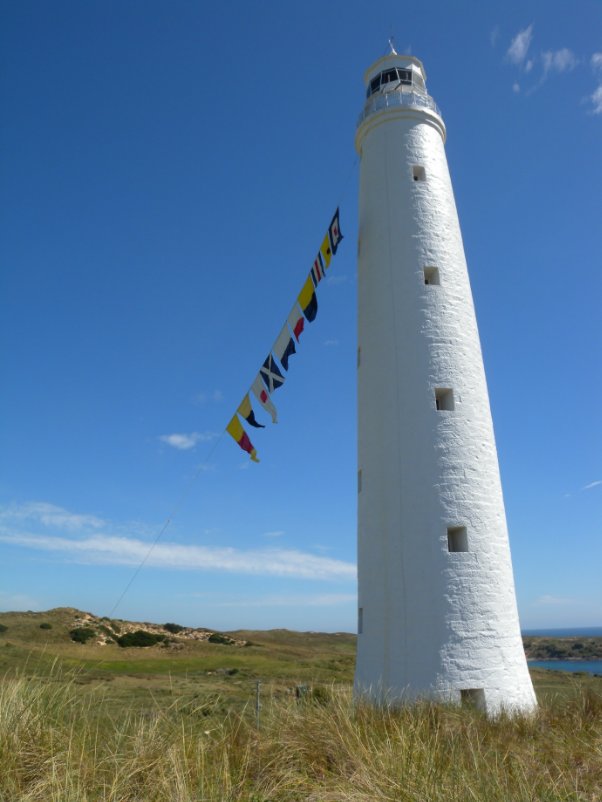
Figure 15. 150th Anniversary Opening Cape Wickham Lighthouse (Source: AMSA, 2011)

4. Fabric register
4.1 Register
The cultural significance of the lighthouse resides in its fabric, and in its intangible aspects – such as the meanings people ascribe to it, and its connections to other places and things. The survival of its cultural value depends on a well-informed understanding of what is significant, and on clear thinking about the consequences of change. The Burra Charter sets out good practice for conserving cultural significance.
(All images in sub-sections 4.1 and 4.2 – © AMSA)
Lighthouse feature: Lantern roof
Description and condition
12-sided pyramidal roof of copper sheets lapped and screwed to ribs. Each face has three sheets – the lower sheet is folded up at the joint, and the upper sheet is folded down.
- Ribs – straight, radial ribs
- Inner skin – none
- Ventilator – ball type, with wind vane attached
- Lightning conductor – vertical pole on roof, with three spikes at top, and two braces to roof, eight vertical spikes attached near the gutter
- Gutter – polygonal fabricated gutter attached to ring of metal pieces bolted together.
- Handrails – none
- Ladder rail – discontinuous, attached to gutter
- Curtain rail – attached to ribs with brackets
Finish | painted |
Condition | intact and sound |
Integrity | high |
Significance | high |
Maintenance | keep in service prepare and repaint at normal intervals |
Rectification Works | none |
Heritage significance: High
The lantern roof is an essential part of the lighthouse – exhibiting a style of lighthouse built throughout the 1860s (criterion a, criterion d)
The lantern roof contributes to the aesthetic value of the lighthouse (criterion e)
Lighthouse feature: Lantern glazing


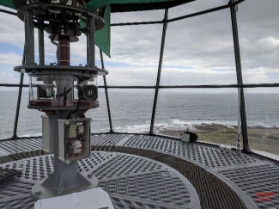
© AMSA, 2020
Description and condition
1861 Wilkins & Co.
- Panes – flat trapezoidal glass, three tiers. Upper tier, and some panes of the lower tier, painted out.
- Astragals – vertical and horizontal astragals of lamb’s tongue section, bolted to roof ring at top, and to lantern base below.
- Handholds – one on each vertical astragal, fixed to cover strips.
Finish | astragals and glazing strips painted |
Condition | intact and sound |
Integrity | high |
Significance | high |
Maintenance | keep in service reglaze as necessary prepare and repaint at normal intervals |
Rectification Works | none |
Heritage significance: High
The lantern glazing is both an original and essential part of a historic lighthouse – exhibiting a design of lighthouses built throughout the 1860s (criterion a, criterion d)
The lantern glazing contributes to the aesthetic value of the lighthouse (criterion e)
Lighthouse feature: Internal catwalk
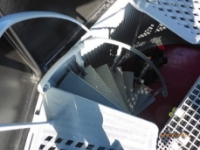



© AMSA, 2020
Description and condition
1861 Wilkins & Co cast iron lattice floor panels supported on cast iron brackets bolted to the lantern base. The brackets also support a circular cast iron lattice platform.
- Ladder – fixed winding stair with cast iron treads cantilevered from a central iron post. Wrought iron handrail on cast iron balusters.
- Aluminium grating – recent aluminium grating installed to span the gap between the catwalk panels and the platform as a safety measure for service personnel. Grating supported on both the catwalk brackets and an aluminium angle.
Finish | painted |
Condition | intact and sound |
Integrity | high |
Significance | recent aluminium grating: low other parts: high |
Maintenance | keep in service prepare and repaint at normal intervals |
Rectification Works | none |
Heritage significance: High
The internal catwalk is both an original and essential part of a historic lighthouse (criterion a).
Lighthouse feature: External catwalk

© AMSA, 2020
Description and condition
1861 Wilkins & Co cast iron lattice floor panels supported on pierced cast iron brackets bolted to the lantern base.
One floor panel has been removed and brackets on either side of the opening formed have been modified.
- Handrail – None.
Finish | painted |
Condition | intact and sound |
Integrity | high |
Significance | high |
Maintenance | keep in service prepare and repaint at normal intervals |
Rectification Works | none |
Heritage significance: High
The external catwalk is both an original and essential part of a historic lighthouse – exhibiting a design of lighthouses built throughout the 1860s (criterion a, criterion d).
The external catwalk contributes to the aesthetic value of the lighthouse (criterion e).
Lighthouse feature: Lantern base

© AMSA, 2020
Description and condition
1861 Wilkins & Co, irregular 12-sided polygonal prism in form, with alternating long and short faces. Panels of cast iron bolted together with flanged joints. Decorative corrugated relief pattern on outside.
- Internal lining – corrugated iron of fine pitch.
- Vents – external vents sealed. Internal circular openings below the internal catwalk.
- Door – fibreglass door hung on double-knuckle hinges and secured with two strong-backs with hand wheels. The door closes against rubber seals.
Finish | painted |
Condition | intact and sound |
Integrity | high |
Significance | high |
Maintenance | keep in service prepare and repaint at normal intervals |
Rectification Works | none |
Heritage significance: High
The lantern base is both an essential and original part of a historic lighthouse – exhibiting one particular design of lighthouses built throughout the 1860s (criterion a, criterion d).
Lighthouse feature: Lantern floor
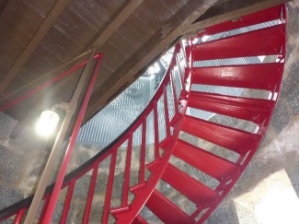
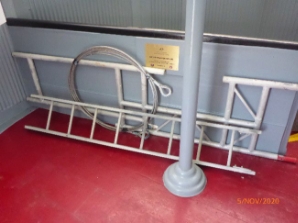
© AMSA, 2020
Description and condition
Timber floor of pit-sawn boards supported on pit-sawn joists built into the tower walls, with overlay of wide machine-sawn boards. Lines of tack marks indicate a previous overlay of linoleum.
Finish | painted |
Condition | intact and sound |
Integrity | high |
Significance | high |
Maintenance | keep in service prepare and repaint at normal intervals |
Rectification Works | none |
Heritage significance: High
The lantern floor is both an early and essential part of a historic lighthouse – exhibiting one particular design of lighthouses built throughout the 1860s (criterion a, criterion d).
Lighthouse feature: Lens assembly



© AMSA, 2020
Description and condition
1946 Chance Bros six panel catadioptric lens assembly of 250mm focal radius in gunmetal frame. Fitted with rotating frame with suspended cloth masks to stop parasitic flashes.
Condition | intact and sound |
Integrity | high |
Significance | moderate |
Maintenance | keep in service clean at normal intervals |
Rectification Works | none |
Heritage significance: Moderate
The lens assembly is both an early and essential part of a historic lighthouse (criterion a).
The lens assembly contributes to the aesthetic values of the lighthouse (criterion e).
Lighthouse feature: Pedestal
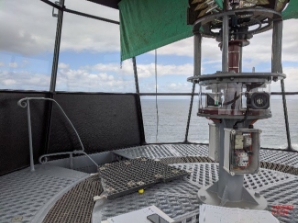
 © AMSA, 2020
© AMSA, 2020
Description and condition
1918 cast iron pedestal mounted on the 1861 platform, with 1988 twin motor-gearbox electric drive fixed on top.
Condition | intact and sound |
Integrity | high |
Significance | moderate |
Maintenance | prepare and repaint at normal intervals |
Rectification Works | none |
Heritage significance: Moderate
The pedestal is both an early and essential part of a historic lighthouse (criterion a).
Lighthouse feature: Light source
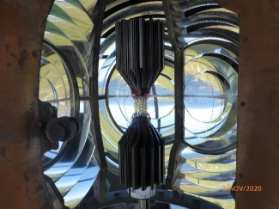 © AMSA, 2020
© AMSA, 2020
Description and condition
Sealite SL-LED-324-W; 12 sided- 36LED light source mounted on existing pillar.
Condition | intact and sound |
Integrity | high |
Significance | low |
Maintenance | none |
Rectification Works | none |
Heritage significance: Low
Lighthouse feature: Balcony floor

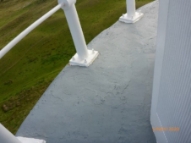
© AMSA, 2020
Description and condition
1918 concrete on top of the 1861 stone cornice. This floor replaced the original wider floor of cast iron.
Finish | painted |
Condition | intact and sound |
Integrity | high |
Significance | moderate |
Maintenance | keep in service prepare and repaint at normal intervals |
Rectification Works | none |
Heritage significance: Moderate
The balcony floor is both an early and essential part of a historic lighthouse (with the 1861 stone cornice being an original feature) (criterion a).
The balcony floor contributes to the aesthetic value of the lighthouse (criterion e).
Lighthouse feature: Balcony balustrade
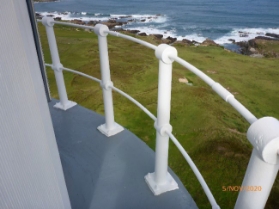 © AMSA, 2020
© AMSA, 2020
Description and condition
1918 iron balustrade with cast stanchions bolted to balcony floor. Top and bottom rails of round section.
Finish | painted |
Condition | intact and sound |
Integrity | high |
Significance | high |
Maintenance | keep in service prepare and repaint at normal intervals |
Rectification Works | none |
Heritage significance: High
The balcony balustrade is both an early and essential part of a historic lighthouse (criterion a).
The balcony balustrade contributes to the aesthetic value of the lighthouse (criterion e).
Lighthouse feature: Walls



© AMSA, 2020
Description and condition
1861 walls of tooled stone blocks.
Finish | exterior: painted interior: bare stone |
Condition | intact and sound |
Integrity | high |
Significance | high |
Maintenance | keep in service prepare and repaint at normal intervals monitor condition of pointing and stonework |
Rectification Works | none |
Heritage significance: High
The walls are both an essential and original part of a historic lighthouse – its coursed stonework exhibiting one particular style of lighhtouses built throughout the 1860s (criterion a, criterion d).
The walls contriute to the rarity of the tower’s height (criterion b).
The walls contribute to the aesthetic value of the lighthouse (criterion e).
Lighthouse feature: Windows







© AMSA, 2020
Description and condition
Fixed glazing in timber window sashes in timber frames.
Finish | frames and sashes: painted glass: clear |
Condition | intact and sound |
Integrity | high |
Significance | window openings: high frames and glazing: low |
Maintenance | keep in service prepare and repaint at normal intervals |
Rectification Works | none |
Heritage significance: High
The window openings are an original and essential part of a historic lighthouse – exhibiting a style of lighthouses built throughout the 1860s (criterion a, criterion d).
The window openings contribute to the aesthetic value of the lighthouse (criterion e).
Lighthouse feature: Ground floor door
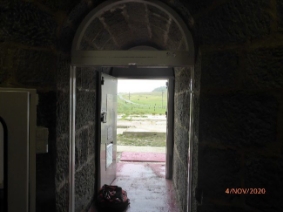

© AMSA, 2020
Description and condition
Recent timber framed and sheeted door, faced with stainless steel, hung in timber frame with iron semi-circular frame above.
Finish | outside of door: bare metal other parts: painted |
Condition | intact and sound |
Integrity | high |
Significance | moderate |
Maintenance | keep in service prepare and repaint at normal intervals |
Rectification Works | none |
Heritage significance: Moderate
The ground floor door is an essential part of a historic lighthouse with some historic features (i.e. timber frame) (criterion a).
Lighthouse feature: Intermediate floors


© AMSA, 2020
Description and condition
Ten 1861 intermediate timber floors (with later full or partial replacements), with machine-sawn joists and floorboards.
Finish | painted |
Condition | intact and sound |
Integrity | high |
Significance | high |
Maintenance | keep in service prepare and repaint at normal intervals |
Rectification Works | none |
Heritage significance: High
The intermediate floors are both an original and essential parts of a historic lighthouse (criterion a).
The timber intermediate floors are a feature unique to the lighthouse (criterion b).
The intermediate floors contribute to the aesthetic value of the lighthouse (criterion e).
Lighthouse feature: Stairs


© AMSA, 2020
Description and condition
1861 geometric stair with timber treads on recent stainless steel stringers and fasteners.
- Balustrade – 1861 curved timber handrail and timber balusters.
Finish | painted |
Condition | some corrosion evident, otherwise intact and sound |
Integrity | high |
Significance | high |
Maintenance | keep in service, prepare and repaint at normal intervals |
Rectification Works | none |
Heritage significance: High
The timber stairs are both an essential and original part of a historic lighthouse (criterion a).
The timber stairs are a feature unique to the lighthouse (criterion b).
The timber stairs contribute to the aesthetic value of the lighthouse (criterion e).
Lighthouse feature: Ground floor
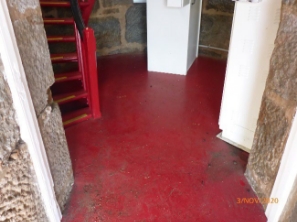
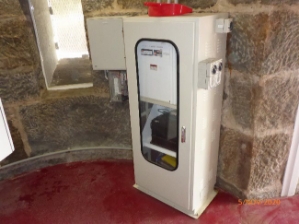
© AMSA, 2020
Description and condition
1861 stone floor with concrete topping.
- Equipment – UPS back up power supply in two separate cabinets.
Finish | painted |
Condition | intact and sound |
Integrity | high |
Significance | high |
Maintenance | keep in service prepare and repaint floor at normal intervals |
Rectification Works | none |
Heritage significance: High
The ground floor is both an original and essential part of a historic lighthouse – exhibiting one style of lighthouses built throughout the 1860s (criterion a, criterion d).
4.2 Related object and associated AMSA artefact
The artefacts listed below are recognised as being of heritage significance to Cape Wickham and registered within AMSA’s artefact catalogue.
 © AMSA, 2020
© AMSA, 2020
Artefact | 150th Anniversary plaque
|
Maximo ID:
Location in lighthouse:
Condition:
| AR0287
Mounted inside lantern room
Good |
4.3 Comparative analysis
Cape Wickham Lighthouse is comprised of features that share similarities with other Tasmanian lighthouses. The 13’ 0” W Wilkins & Co lantern demonstrated a design similar to the 12’ 6” Wilkin & Co lantern installed in Swan Island Lighthouse (first lit 1845), and the Wilkins & Co lantern installed in Goose Island Lighthouse (first lit 1846). All three Tasmanian lighthouses are located offshore from the Tasmanian mainland, and both Cape Wickham and Goose Island lighthouses underwent similar alterations to their fabric in 1918. For example, the installation of iron balustrade with cast stanchions along the balconies.
Despite variations in design and fabric, Swan Island, Goose Island and Cape Wickham lighthouses are indicative of the typical stone lighthouse favoured for construction along Bass Strait throughout the mid-19th century.
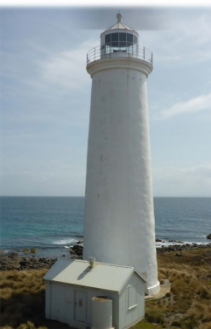
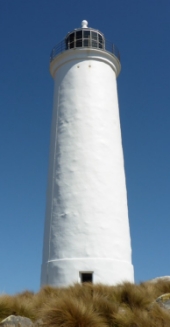
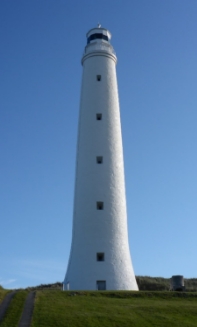
Figure 16. From left to right: Swan Island Lighthouse (1845), Goose Island Lighthouse (1846), and Cape Wickham Lighthouse (1861) (Source: AMSA)

5. Heritage significance
5.1 Commonwealth heritage listing – Cape Wickham Lighthouse
The statement of significance and heritage value criteria listed below are directly taken from the Commonwealth heritage listing for the Cape Wickham Lighthouse (Place ID: 105567).
Commonwealth heritage statement of significance
The Cape Wickham Lighthouse, built 1861, is significant as an integral part of Bass Strait’s mid-nineteenth century network of lighthouses. This system represents the first example of cooperation by the Australian colonies in sharing the costs and responsibilities of providing navigational aids. (Criterion A.4) (Australian Historic Themes 3.8.1 Shipping to and from Australian ports; 3.8.2 Safeguarding Australian products for long journeys and 3.16.1 Dealing with hazards and disasters)
The Cape Wickham Lighthouse makes a dramatic contribution to the rural landscape of the northern tip of King Island. (Criterion E.1)
The Cape Wickham Lighthouse is a good example of a lighthouse built during the 1860s. It is forty eight metres high, which makes it the tallest lighthouse in Australia. It retains the original H Wilkins and Company lantern house and the original timber staircase, a feature that is not common in a stone lighthouse. (Criterion B.2 and D.2)
Commonwealth heritage values criteria
There are nine criteria for inclusion in the Commonwealth Heritage List – meeting any one of these is sufficient for listing a place. These criteria are similar to those used in other Commonwealth, state and local heritage legislation, although thresholds differ. In the following sections, the criteria met by Cape Wickham Lighthouse is discussed as based on the current Commonwealth Heritage Listing (Place ID 105567).
Criterion | Relevant attributes identified | Explanation |
Criterion A – Processes
This criterion is satisfied by places that have significant heritage value because of [their] importance in the course, or pattern, of Australia’s natural or cultural history.
|
| The Cape Wickham Lighthouse, built in 1861, is significant as an integral part of Bass Strait’s mid-nineteenth century network of lighthouses. This system represents the first example of cooperation by the Australian colonies in sharing the costs and responsibilities of providing navigational aids.
|
Criterion B – Rarity
This criterion is satisfied by places that have significant heritage value because of [their] possession of uncommon, rare or endangered aspects of Australia’s natural or cultural history.
|
| It is forty eight metres high, which makes it the tallest lighthouse in Australia. It retains the original H Wilkins and Company lantern house and the original timber staircase, a feature that is not common in a stone lighthouse. |
Criterion D – Typicality
This criterion is satisfied by places that have significant heritage values because of [their] importance in demonstrating the principal characteristics of a class of Australia’s natural or cultural history.
|
| The Cape Wickham Lighthouse is a good example of a lighthouse built during the 1860s. |
Criterion E – Aesthetics
This criterion is satisfied by places that have significant heritage value because of [their] importance in exhibiting particular aesthetic characteristics values by a community or cultural group.
|
| The Cape Wickham Lighthouse makes a dramatic contribution to the rural landscape of the northern tip of King Island. |
5.2 Tasmanian State Heritage Register – Cape Wickham Lighthouse
Cape Wickham Lighthouse is listed on the Tasmanian Heritage Register (THR ID: 3613). The statement of significance and heritage values criteria are directly taken from the listing.
State heritage statement of significance
No statement of significance is provided for places listed prior to 2007.
TAS State heritage criteria
There are eight criterions identified within the Tasmanian Heritage Register – Cape Wickham Lighthouse meets the following five criterions.
State Heritage Register criterion (SHR) | Evidence/Explanation |
SHR Criterion A – The place is important to the course or pattern of Tasmania’s history. | Historically, the Cape Wickham Lighthouse has played an important role in the development of a coastal lighting system and the expansion of commercial activity within the Bass Strait region. The 1861 tower and pre-1918 archaeological remnants of the station settlement are among the oldest structures on King island.
|
SHR Criterion B – The place possesses uncommon or rare aspects of Tasmania’s history.
| The gently tapering form of the Cape Wickham Lighthouse is significant as the tallest light tower in Australia. |
SHR Criterion C – The place has the potential to yield information that will contribute to an understanding of Tasmania’s history. | The Cape Wickham Lightstation is of historic heritage significance because of its potential to provide information about the early operation of the Lightstation through its archaeological deposits.
|
SHR Criterion D – The place is important in demonstrating the principal characteristics of a class of place in Tasmania’s history. | The Cape Wickham Lighthouse is of historic heritage significance because it represents the principal characteristics of a Mid-Victorian lighthouse.
|
SHR Criterion F – The place has a strong or special association with a particular community or cultural group for social or spiritual reasons. | The Cape Wickham Lighthouse is of a historic heritage significance as a dramatic landmark feature valued by the community.
|
These heritage values, identified and explained in the Commonwealth heritage list and the Tasmanian Heritage Register, will form the basis of the management of Cape Wickham Lighthouse. In the event of necessary works, all criteria will be consulted to inform best practice management of the values associated with the lighthouse. (See Section 7 – Conservation management policies for further information on strategies to conserve Cape Wickham Lighthouse’s heritage values).
5.3 Condition and integrity of the Commonwealth heritage values
Condition is measured on a Good – Fair – Poor scale and incorporates the current condition of the specific value. Integrity is measured on a High – Medium – Low scale which incorporates the value’s intactness.
The Cape Wickham Lighthouse’s heritage values maintain good condition and medium-high integrity (the replacement of the original balcony have had a slight impact on the integrity of Criterion D).
Criteria | Values (including attributes) | Condition | Integrity |
Criteria A – Processes
| The Cape Wickham Lighthouse, built in 1861, is significant as an integral part of Bass Strait's mid-nineteenth century network of lighthouses. This system represents the first example of cooperation by the Australian colonies in sharing the costs and responsibilities of providing navigational aids.
| Good | High |
Criteria B – Rarity
| It is forty eight metres high, which makes it the tallest lighthouse in Australia. It retains the original H Wilkins and Company lantern house and the original timber staircase, a feature that is not common in a stone lighthouse.
| Good | High |
Criteria D – Typicality
| The Cape Wickham Lighthouse is a good example of a lighthouse built during the 1860s.
| Good | Medium – High |
Criteria E – Aesthetic
| The Cape Wickham Lighthouse makes a dramatic contribution to the rural landscape of the northern tip of King Island.
| Good | High |
5.4 Gain/loss of heritage values
Evidence for the potential gain or loss of heritage values will be documented within this section of future versions of this heritage management plan.

6. Opportunities and constraints
6.1 Implications arising from significance
The Commonwealth statement of significance (section 5.1 above) demonstrates that Cape Wickham Lighthouse is a place of considerable heritage value due to its contribution to the 19th century of lighthouses within Bass Strait, its standing as the tallest Australian lighthouse, the retention of its original Wilkins & Co. lantern house and timber staircase, and its aesthetic appeal on the landscape.
The implication arising from this assessment is that key aspects of the place should be conserved to retain this significance. The key features requiring conservation include:
- architectural quality of the building
- original Wilkins Co. lantern house
- original, unique timber staircase
- movable artefacts (see Section 4.2)
- interior spaces and features which are notable for their design, details, and/or their original lighthouse function:
- intermediate floors
- ground floor
- lantern room
- lens assembly
- external spaces and features which are notable for their design, details, and/or their original lighthouse function:
- lantern roof and glazing
- external catwalk, and balcony
- lighthouse walls, windows
Referral and approvals of action
The Act provides that actions:
- taken on Commonwealth land which are likely to have a significant impact on the environment will require the approval of the Minister.
- taken outside Commonwealth land which are likely to have a significant impact on the environment on Commonwealth land, will require the approval by the Minister.
- taken by the Australian Government or its agencies which are likely to have a significant impact on the environment anywhere will require approval by the Minister.
Heritage strategy
If an Australian Government agency owns or controls one or more places with Commonwealth heritage values, it must prepare a heritage strategy within two years from the first time they own or control a heritage place (section 341ZA).
A heritage strategy is a written document that integrates heritage conservation and management within an agency’s overall property planning and management framework. Its purpose is to help an agency manage and report on the steps it has taken to protect and conserve the Commonwealth heritage values of the properties under its ownership or control.
The heritage strategy for AMSA’s AtoN assets was completed and approved by the minister in 2018.[28]
Heritage asset condition report
A heritage asset condition report is a written document that details the heritage fabric of a site with an in-depth description of each architectural and structural element. The document includes: a brief history of the site, the Commonwealth Heritage statement of significance and value criteria, a heritage significance rating for each individual element, and a catalogue of artefacts on-site. The document is also accompanied by up-to-date photos of each structural element. This document operates as a tool for heritage monitoring, and is reviewed and updated biennially.
Aboriginal heritage significance
King Island as a whole is notable for its Aboriginal heritage significance and natural values. Although these values lie outside of the Commonwealth heritage listing curtilage and AMSA’s lease, the potential remains for future works at the lighthouse to impact these values. At the time this plan was written, no plans have been made for future works at Cape Wickham Lighthouse. In the event major works at the lighthouse are to be carried out, AMSA will seek to minimise impacts to the surrounding area by:
- Utilising specific access tracks to ensure no damage to surrounding vegetation,
- Ensuring project footprint is limited to the AMSA lease. In any instance that work is required outside of this footprint, approvals will be sought from the appropriate stakeholders including TAS PWS, and the Office of Aboriginal Affairs (Tas),
- Implementing an appropriate discovery plan in the instance Aboriginal cultural heritage is suspected and/or found.
6.2 Framework: sensitivity to change
The heritage values identified by both Commonwealth and state demonstrate Cape Wickham Lighthouse is of high significance. Therefore, work actioned by AMSA on the lighthouse’s fabric harnesses the potential to reduce or eradicate the significance of the site’s heritage values.
Conservation works, including restoration and reconstruction, or adaptation works of the absolute minimum so as to continue the lighthouse’s usefulness as an AtoN are the only works that should be actioned by AMSA on Cape Wickham Lighthouse. Some exceptions are made for health and safety requirements, however any and all work carried out must be conducted in line with heritage considerations and requirements of the EPBC Act.
The table below demonstrates the level of sensitivity attributed to the various elements of the fabric register in the face of change. These are measured on a High-Moderate-Low spectrum depending on the action’s possible threat to the site’s heritage values.
High sensitivity
High sensitivity to change includes instances wherein a change would pose a major threat to the heritage value of a specific fabric, or the lighthouse as a whole. A major threat is one that would lead to substantial or total loss of the heritage value.
Moderate sensitivity
Moderate sensitivity to change includes instances wherein a change would pose a moderate threat to the heritage value of a specific fabric, or would pose a threat to the heritage significance of a specific fabric in another part of the building. A moderate threat is one that would diminish the heritage value, or diminish the ability of an observer to appreciate the value.
Low sensitivity
Low sensitivity to change includes instances wherein a change would pose little to no threat to the heritage value of a specific fabric, and would pose little to no threat to heritage significance in another part of the building.
Component | Level of sensitivity | Nature of change impacting heritage values
|
Cape Wickham Lighthouse structure | High |
|
Low |
| |
Ground, and intermediate floors | High |
|
Low |
| |
Timber staircase | High |
|
Low |
| |
Balcony | High |
|
Low |
| |
Lens assembly, and pedestal | Moderate |
|
Low |
| |
Lantern house | High |
|
Low |
|
6.3 Statutory and legislative requirements
The following table outlines the statutory and legislative requirements relevant to the conservation and management of Cape Wickham Lighthouse.
Act or Code | Description |
Environment Protection and Biodiversity Conservation Act 1999 (Cth) | The Environment Protection & Biodiversity Conservation Act 1999 (Cth) requires agencies to prepare management plans that satisfy the obligations included in Schedule 7A and 7B of the EPBC Regulations. |
Environment Protection and Biodiversity Conservation Regulations 2000 (Cth) | The Commonwealth Department of Agriculture, Water and the Environment has determined these principles to guide for excellence in managing heritage properties.
- Have a particular interest in, or associations with, the place; and - May be affected by the management of the place
|
AMSA Heritage Strategy | As the custodian of many iconic sites, the Australian Maritime Safety Authority (AMSA) has long recognised the importance of preserving their cultural heritage. This Heritage Strategy is in response to section 341ZA of the EPBC Act which obliges AMSA to prepare and maintain a heritage strategy, along with obliging AMSA to:
The strategy derives from the AMSA Corporate Plan and achievements are reported through the AMSA Annual Report.[29]
|
Navigation Act 2012 (Cth) | Part 5 of the Act outlines AMSA’s power to establish, maintain and inspect marine aids to navigation (such as Cape Wickham Lighthouse). (1) AMSA may: (a) Establish and maintain aids to navigation; and (b) Add to, alter or remove any aid to navigation that is owned or controlled by AMSA; and
(c) Vary the character of any aid to navigation that is owned or controlled by AMSA.
(2) AMSA, or person authorised in writing by AMSA may, at any reasonable time of the day or night: (a) Inspect any aid to navigation or any lamp or light which, in the opinion of AMSA or the authorised person, may affect the safety or convenience of navigation, whether the aid to navigation of the lamp or light is the property of: (i) A state or territory; or (ii) An agency of a state or territory; or (iii) Any other person; and
(b) Enter any property, whether public or private, for the purposes of an inspection under paragraph (a); and
(c) Transport, or cause to be transported, any good through any property, whether public or private, for any purpose in connection with: (i) The maintenance of an aid to navigation that is owned or controlled by AMSA; or (ii) The establishment of any aid to navigation by AMSA.
|
Australian Heritage Council Act 2003 (Cth) | This Act establishes the Australian Heritage Council, whose functions are:
|
TAS Historic Cultural Heritage Act 1995 (Tas) | This Act establishes the Tasmanian Heritage Council.
7 General functions and powers of Heritage Council (1) The functions of the Heritage council are – (a) to advise the Minister on matters relating to Tasmania's historic cultural heritage and the measures necessary to conserve that heritage for the benefit of the present community and future generations; and
(b) to work within the planning system to achieve the proper protection of Tasmania's historic cultural heritage; and
(c) to co-operate and collaborate with Federal, state and local authorities in the conservation of places of historic cultural heritage significance; and
(d) to encourage and assist in the proper management of places of historic cultural heritage significance; and
(e) to encourage public interest in, and understanding of, issues relevant to the conservation of Tasmania's historic cultural heritage; and
(f) to encourage and provide public education in respect of Tasmania's historic cultural heritage; and
(g) to assist in the promotion of tourism in respect of places of historic cultural heritage significance; and
(h) to keep proper records, and encourage others to keep proper records, of places of historic cultural heritage significance; and
(i) to perform any other function the minister determines.
(2) The Heritage Council may do anything necessary or convenient to perform its functions.
|
National Parks and State Reserve Management 2002 (Tas) | Schedule 1, Section 8: Historic site
The following objectives: (a) to conserve sites or areas of historic cultural significance; (b) to conserve natural biological diversity; (c) to conserve geological diversity; (d) to preserve the quality of water and protect catchments; (e) to encourage education based on the purposes of reservation and the natural or cultural values of the historic site, or both; (f) to encourage research, particularly that which furthers the purposes of reservation; (g) to protect the historic site against, and rehabilitate the historic site following, adverse impacts such as those of fire, introduced species, diseases and soil erosion on the historic site’s natural and cultural values and on assets within and adjacent to the historic site; (h) to encourage tourism, recreational use and enjoyment consistent with the conservation of the historic site’s natural and cultural values; (i) to encourage cooperative management programs with Aboriginal people in areas of significance to them in a manner consistent with the purposes of reservation and the other management objectives.
|
Building Code of Australia/National Construction Code | The Code is the definitive regulatory resource for building construction, providing a nationally accepted and uniform approach to technical requirements for the building industry. It specifies matters relating to building work in order to achieve a range of health and safety objectives, including fire safety.
As far as possible, Commonwealth agencies aim to achieve compliance with the Code, although this may not be entirely possible because of the nature of and constraints provided by existing circumstances, such as an existing building.
|
Work Health and Safety Act 2011 (Cth) | The objectives of this Act include: (1) The main object of this Act is to provide for a balanced and nationally consistent framework to secure the health and safety of workers and workplaces by:
a) protecting workers and other persons against harm to their health, safety and welfare through the elimination of minimisation of risks arising from work; and
b) providing for fair and effective workplace representation, consultation, co-operation and issue resolution in relation to work health and safety; and
c) encouraging unions and employer organisations to take a constructive role in promoting improvements in work health and safety practices, and assisting persons conduction businesses or undertakings and workers to achieve a healthier and safer working environment; and
d) promoting the provision of advice, information, education and training in relation to work health and safety; and
e) securing compliance with this Act through effective and appropriate compliance and enforcement measures; and
f) ensuring appropriate scrutiny and review of actions taken by persons exercising powers and performing functions under this Act; and
g) providing a framework for continuous improvement and progressively higher standards pf work health and safety; and
h) maintaining and strengthening the national harmonisation of laws relating to work health and safety and to facilitate a consistent national approach to work health and safety in this jurisdiction. [Quoted from Division 2 of Act]
This has implications for Cape Wickham Lighthouse of Australia as it is related to AMSA staff, contractors and visitors.
|
6.4 Operational requirements
As a working AtoN, the operational needs of Cape Wickham Lighthouse are primarily concerned with navigational requirements
Below are the operational details and requirements of Cape Wickham light as outlined by AMSA.
Navigational requirement for AMSA’s AtoN Site | ||
1 | Objective/rationale | An AtoN is required at Cape Wickham on the northern tip of King Island in the middle of the western entrance to the Bass Strait. It provides both a landfall mark to the Strait and a navigation mark for vessels transiting either east / west through it or across it. The Strait has complex sea limits and the AtoN assists with positioning within these limits. The AtoN also assists in keeping vessels clear of the shoals that lie 2 nautical miles north-east and 5 nautical miles north-west of it.
|
2 | Required type(s) of AtoN | A fixed structure is required to act as a day mark. A distinctive light is required for use at night.
|
3 | Priority/significance | An AtoN at this site is important for the navigation of commercial ships.
|
4 | Required measure of performance | The service performance of the AtoN must comply with the IALA Availability Target Category 2 (99.0%).
|
5 | Primary and secondary means (if any) of identification | The day mark must be conspicuous. The existing 48 m white round stone tower and lantern at an elevation of 85 m meets this requirement. The light must comply with the requirements of rhythmic characters of light as per the IALA Navaguide. The light must have distinct characteristics that are easy to recognise and identify. The present flashing (2) white light every 10 seconds meets this requirement.
|
6 | Visual range | During daytime, the AtoN structure should be visible from at least 5 nautical miles. At night, the white light must have a nominal range of at least 21 nautical miles.
|
7 | Radar conspicuousness | As the cape itself will give a good radar echo, no additional radar enhancement is required for this site.
|
6.5 Occupier needs
AMSA’s goals
AMSA is responsible, under the Navigation Act 2012 (Cth), for maintaining a network of marine AtoN around Australia’s coastline that assist mariners to make safe and efficient passages. AMSA’s present network of approximately 500 marine AtoN includes traditional lighthouses such as Cape Wickham Lighthouse), beacons, buoys, racons, automatic identification system stations, met ocean sensors including broadcasting tide gauges, current meter, directional wave rider buoys and a weather station.
Technological developments in the area of vessel traffic management have also contributed to increasing navigation safety and helped promote marine environment protection. AMSA aims to meet international standards for the reliability of lighthouses set by the International Association of Marine Aids to Navigation and Lighthouse Authorities (IALA).
At the time of preparing this management plan, the major goal for Cape Wickham Lighthouse primarily encompasses continuing its utilisation as an AtoN for as long as necessary while upkeeping the appropriate maintenance to conserve and preserve the heritage values of the lighthouse.
Lighthouse performance standards
AMSA aims to meet international standards for the reliability of lighthouses set by IALA. Cape Wickham is designated as an IALA Availability Category 2 Aid to Navigation (within a scale of Category 1 to Category 3, Category 1 aids are most critical). Category 2 aids have an availability target of 99.0 per cent.
Access to the lighthouse
One practical effect of this performance standard is that the operational equipment and structure of the light need to be kept in good repair by regular preventative maintenance and equipment that fails in service is repaired quickly. Routine maintenance and emergency repairs are carried out by AMSA’s maintenance contractor. The contractor needs reliable access to the site for this work, and AMSA officers need access for occasional inspections of the site including auditing the contractor’s performance.
6.6 Proposals for change
Preventative maintenance works are carried out on the lighthouse to maintain its status as a working marine AtoN, and to assist in the site’s conservation.
A list of scheduled preventative maintenance work is identified within the latest available site inspection report. The information provided below was taken from this report:
Maintenance description | Expected maintenance date |
Cape Wickham reseal glazing | 2025 |
Cape Wickham lantern room paint | 2025 |
Cape Wickham structure paint | 2029 |
Cape Wickham LED array replacement | 2029 |
6.7 Potential pressures
6.8 Process for decision-making
Processes for decision-making are required in the event of incidents that impact the heritage values of the site. The following incidents are included due to their likelihood of occurrence at the Cape Wickham Lighthouse.
Incident | Procedure |
Major project/maintenance works proposed |
|
Damage to lighthouse’s fabric (heritage significance) |
|
Damage to lighthouse’s fabric (no heritage significance) |
|
Light upgrade |
|
Minor modification to lighthouse, such as adding of attachment |
|
Unforeseen discovery of Aboriginal artefacts on-site. |
|
Divestment of lighthouse from AMSA |
|
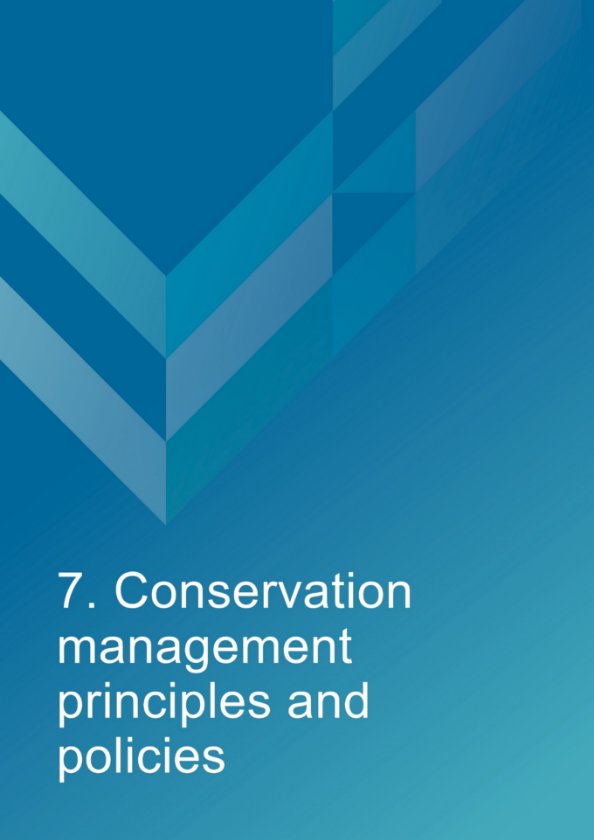
7. Conservation management principles and policies
7.1 Policies
Note: The management of sensitive information is not relevant to AMSA’s heritage strategy and therefore bears no relevance in this management plan.
Fabric and setting
AMSA’s main purpose is to facilitate the ongoing operation of the site as a marine AtoN while preserving the site’s heritage values. As part of a heritage monitoring program, Heritage Asset Condition Reports are produced for each site every two years to evaluate the condition of the heritage fabric and values. Routine servicing is also carried out by maintenance contractors. Regular written reports from these visits will be sent to AMSA Asset Management and Preparedness for review and any work requirements identified will be scheduled accordingly. Should for some unforeseen reason the site no longer be viable as a marine AtoN, management responsibilities will be passed to the appropriate state or federal authority to ensure preservation of the heritage assets.
Implementation strategy:
- AtoN Maintenance contractor will continue scheduled periodic maintenance of the lighthouse and marine aid to navigation every 12 months to ensure condition is monitored for early warning of deterioration. Schedule must be approved by AMSA Asset Management and Preparedness.
- AMSA Asset Management and Preparedness to arrange for maintenance to be carried out on the lighthouse as required while continuing to operate as an AMSA marine aid to navigation.
- AMSA Asset Management and Preparedness to arrange for the replacement and upgrading of marine aid to navigation equipment in the lighthouse as required to meet AMSA’s service commitment, in a manner that preserves the original fabric of the lighthouse.
- AMSA Asset Management and Preparedness to maintain information on the heritage fabric of the lighthouse including any and all actions, treatments and inspection outcomes within the heritage fabric register.
- AMSA Asset Management and Preparedness to conserve all the fabric elements identified as significant in the heritage asset condition report.
- AMSA Asset Management and Preparedness to seek expert materials conservation advice when considering repair, restoration and reconstruction of historic fabric. The relevant local, state and federal heritage approvals must be sought prior to repair, restoration and reconstruction.
- AMSA AtoN Heritage Coordinator to conserve the distinctive character of the lightstation by collecting photographic evidence and historical documentation of the original fabric.
Uses
Policy 2 – Install and operate equipment in the lighthouse, so it continues to function as an effective marine AtoN, in such a way as to impose the least possible harm to the significant fabric.
Cape Wickham Lighthouse’s use as a working marine AtoN is of high priority. Carrying out maintenance, including upgrades to AtoN equipment, is necessary to its function and continued marine safety along the TAS coast. In the event of the installation and/or upgrade to AtoN equipment, proper precaution will be taken to ensure the least possible harm is done to significant fabric.
Implementation strategy:
- AtoN Maintenance Contractor to monitor Cape Wickham’s AtoN equipment every 12 months and propose maintenance in the instance of necessary installation or removal. Proposed maintenance is to be approved by AtoN Asset Management and Preparedness.
- AMSA Asset Management and Preparedness to outline all possible risks to significant fabric, external and internal, associated with the installation, removal and operation of equipment.
- AMSA Asset Management and Preparedness to ensure works carried out are those that ensure the least possible harm to significant fabric.
- AMSA Asset Management and Preparedness to seek expert heritage conservation advice on best practice management of the site during installation, removal and operation of equipment.
Policy 3 – Monitor possible impacts to the site resulting from tourism, and control appropriate access to the lighthouse for contractors and visitors.
Cape Wickham’s location and layout allows relatively easy public access, day or night. Access inside the lighthouse is restricted to authorised personnel, such as contractors and AMSA employees. AMSA personnel and contractors require easy access inside the lighthouse precinct and tower for periodical site visits to carry out inspections and routine maintenance.
Implementation strategy:
- AtoN Maintenance contractor to ensure control on access to all buildings within AMSA’s lease area is maintained by periodically inspecting restricted access inside the lighthouse tower during maintenance visits every 12 months.
- AtoN Maintenance contractor to inspect lighthouse for signs of wear and tear attributed to visitor intake during yearly maintenance visit, and note changes in Heritage Asset Condition Report.
- AMSA Asset Management and Preparedness to ensure contractors are made aware of the heritage values of the lighthouse.
- AMSA Asset Management and Preparedness to ensure access to site is available for Traditional stakeholders to maintain cultural traditions.
Interpretation
Policy 4 – Accurate and relevant interpretation of the history and significance of the place should be made available to site users/visitors and for offsite external research.
AMSA will continue to make information available through the maintenance of site interpretive signage and its website.
Implementation strategy:
- All relevant information concerning the history and significance of the place will be checked for accuracy and updated appropriately.
- Information will be presented primarily as online resources accessible to relevant personnel and the general public. On-site interpretative signage will be utilised where possible.
- This information will be maintained and updated in accordance with changes to the history and significance of the place.
Management
Policy 5 – AMSA will continue to conserve the lighthouse in accordance with Commonwealth and TAS State heritage listing requirements.
For works requiring heritage approval, AMSA will obtain permission from all relevant state or federal authorities. Continuous and as needed conservation works will be undertaken as required.
Implementation strategy:
- AMSA Asset Management and Preparedness to liaise with the relevant federal and state agencies when proposing work on the site.
- AMSA Asset Management and Preparedness to consult with TAS PWS when proposing work on site.
- Approval in writing must be granted for any proposals for development.
Policy 6 – The cultural significance of the lighthouse will be the basis for deciding how to manage it.
The heritage values or cultural significance of the place must be conserved. This heritage management plan includes relevant background information to support this policy (see Section 3 History).
Implementation strategy:
- AMSA to conserve the lighthouse to protect its heritage values (cultural significance).
- When possible, AMSA will strive to maintain the original fabric of the lighthouse.
- AMSA to utilise the Burra Charter as the primary guide for treatment of fabric.
- AMSA Asset Management and Preparedness to engage appropriately qualified heritage consultants when making decisions regarding impact on heritage values.
- AMSA Asset Management and Preparedness to assess impacts on the heritage values of the place when considering proposed alterations or adaptations.
Policy 7 – Monitor, review and report the Commonwealth heritage values of the Lighthouse every five years or sooner if major changes to the lighthouse occur.
The Commonwealth heritage values of the lighthouse are to be monitored and reported on a regular basis. A Heritage Asset Condition Report is updated for Cape Wickham Lighthouse every two years. The report records historical information, condition, and maintenance requirements for fabric within the lighthouse to ensure a gain and/or loss of heritage value is identified.
Implementation strategy:
- AMSA Asset Management and Preparedness to regularly monitor the lighthouse for possible impacts on the identified Commonwealth heritage values.
- AMSA Asset Management and Preparedness to review the current Commonwealth heritage values at least once every five years and assess any gain or loss of values. This review must be undertaken in the event of any major alterations to the lighthouse.
- AMSA Asset Management and Preparedness to report any changes to the Commonwealth heritage values of the lighthouse to the Department of Agriculture, Water and the Environment (Heritage Branch).
- AMSA Asset Management and Preparedness to update AMSA’s heritage strategy and this plan to reflect any changes identified.
- AMSA Maintenance Contractor to review and update Heritage Asset Condition Report biennially.
Policy 8 – Maintain historical, management and maintenance records within AMSA and make available these records.
As part of the proper process for managing change in significant places, the Burra Charter points out the importance of making records before any change, and advocates placing records in a permanent archive, and making them available where this is appropriate. AMSA’s collection of records, which include documents pertaining to heritage intervention, management and maintenance, are subject to this process. Heritage Asset Condition Reports are routinely generated for each lighthouse and stored in AMSA’s recordkeeping system. AMSA will continue to practice such processes via their Records Management Systems (RMS).
Implementation strategy:
- AMSA to maintain, review and update records through existing AMSA RMS as required.
- AMSA to ensure records are made available to the relevant personnel and parties as required.
Policy 9 – Develop and provide appropriate training and resources to all relevant AMSA staff, contractors and licensees.
In order to ensure best practice management of AMSA-operated lighthouses, all staff, contractors and licensees should have access to the appropriate training and resources in order to provide best practice conservation of the site.
Implementation strategy:
- Provide staff personnel involved with the management and maintenance of Cape Wickham Lighthouse access to up-to-date versions of the AMSA heritage strategy, heritage management plans and fabric registers.
- When funds are made available, AMSA Asset Management and Preparedness staff will undertake relevant training to ensure comprehension of the Commonwealth heritage and EPBC Act statutory requirements.
- Develop and provide appropriate training for contractors engaged with heritage sites to ensure comprehension of the Commonwealth heritage and EPBC Act statutory requirements.
- AMSA representatives will attend Commonwealth-run heritage workshops, programs and conferences for up-to-date information on statutory requirements and best-practice management of sites of national and state heritage significance.
- All current and incoming tour guides operating within AMSA lighthouses will be required to take the lighthouse tour guide safety induction e-learning module once every two years to stay informed on heritage values, visitor safety and duty-of-care of the site’s heritage values.
Policy 10 – Use contractors and service providers with appropriate experience.
AMSA is to ensure parties carrying out work have appropriate knowledge and use best practice methods to ensure conservation of the lighthouse.
Implementation strategy:
- AMSA Asset Management and Preparedness to engage staff and contractors with the relevant experience and expertise concerning conservation of the lighthouse.
- Develop and provide the appropriate training on heritage conservation matters for AMSA Asset Management and Preparedness staff and other relevant parties who hold responsibility for heritage management.
Policy 11 – Seek heritage advice and apply best heritage practice.
AMSA will continue to use in-house heritage expertise, external consultancy, or a combination of both as required in order to successfully apply best heritage practice. Should in-house heritage expertise be limited in responding to a requirement, external heritage expertise will be engaged to address the issue.
Implementation strategy:
- AMSA Asset Management and Preparedness to apply in-house heritage expertise when required.
- AMSA Asset Management and Preparedness to use tools such as the Burra Charter and Working Together: Managing Commonwealth Heritage Places (Commonwealth of Australia, 2019) to measure the likely impact of proposals.
- AMSA Asset Management and Preparedness to seek external heritage expertise in the event of limited in-house capability.
Policy 12 – Appropriate protocol in the event of unforeseen discoveries or disturbances of heritage within the AMSA site.
AMSA’s scope of work rarely involves excavation. Should such work need be undertaken, AMSA will implement a suitable discovery plan and seek advice from suitably qualified personnel as required. In the event of any unforeseen discovery or disturbance of heritage-related items on the AMSA site, notification to the appropriate organisation will occur in accordance with the conditions of the discovery plan. This plan will also be updated accordingly.
Note: In most cases, AMSA’s leases are limited to the immediate vicinity of the lighthouse and therefore this scenario is not anticipated as a likely occurrence.
Implementation strategy:
- AMSA Asset Management and Preparedness to consult with the Aboriginal Land Council of Tasmania, Aboriginal Heritage Tasmania, and TAS PWS in the event Aboriginal heritage is suspected.
- AMSA Asset Management and Preparedness to seek appropriate heritage advice and apply best practice in the event of unforeseen discoveries/disturbances.
Policy 13 – Make this Heritage Management Plan available to all persons involved in decision-making on the management of the lighthouse and its setting.
The plan will be made available to all personnel intrinsic to management of the lighthouse and its setting, for example AMSA maintenance contractors, TAS PWS as land manager, staff and other relevant parties.
Implementation strategy:
- AMSA to provide links to this plan via the AMSA website.
- AMSA to provide copies to all relevant personnel and parties.
Future Developments
Policy 14 – Adaptation of the place using methods or processes that minimise impact on heritage values and significance in accordance with The Burra Charter principles.
It is likely that over time the lighthouse will house new equipment as technology changes. The Burra Charter principles will be used as the basis for decision-making.
Implementation strategy:
- AMSA Asset Management and Preparedness to assess the likely impacts of changes on the heritage values and significance of the place.
- AMSA Asset Management and Preparedness to preserve the original fabric of the place and do only what is necessary for the continued use and care of the place.
- AMSA Asset Management and Preparedness to engage expert heritage advice and use The Burra Charter in adapting the place.
Policy 15 – When required, engage with adjacent landowners to maintain an appropriate setting for the lighthouse in its visual and natural context.
Any changes to the surrounding land or AMSA leased area, requires careful consideration. AMSA will liaise with all adjacent landowners in the event of any proposed changes that may affect the setting and attempt to influence a positive outcome.
Implementation strategy:
- AMSA Asset Management and Preparedness to engage with adjacent landowners and TAS PWS through consultation when changes are proposed regarding the wider visual and natural context.
- Consultations will take the form of online correspondence where in-person engagement is not possible.
Policy 16 – In the event of adaptive re-use or divestment (instance(s) which would no longer place the lighthouse under AMSA control) AMSA will strive to ensure the Commonwealth and TAS State heritage values of the site are recognised and preserved.
In the event Cape Wickham Lighthouse is no longer identified as a working AtoN, AMSA will withdraw its standing as lessee and hand over all authority to the lessor. This process must be conducted in line with section 341ZE of the EPBC Act.
Implementation strategy:
- AMSA will negotiate with lessor to have site lease terminated.
- All available heritage information within AMSA’s collection, including this Heritage Management Plan, will be shared with the relevant parties to ensure the Commonwealth and State heritage values of the site are recognised and preserved.
Community Involvement
Policy 17 – Consult with Traditional Stakeholders and the wider community in the preparation of the management plan.
AMSA will give community and Traditional Stakeholder groups, as well as the general public, an opportunity to review and comment on this management plan through a public consultation process.
Implementation strategy:
- AMSA to undertake community consultation when preparing the heritage management plan in accordance with EPBC Regulations.
- AMSA to seek advice from Traditional stakeholders and refer to ‘Engage Early – Guidance for proponents on best practice Indigenous engagement for environmental assessments under the Environment Protection and Biodiversity Conservation Act 1999 (EPBC Act)’ to guide consultations[30].
Review
Policy 18 – Review this plan within 5 years of its adoption or sooner if major changes are needed.
This plan will be reviewed every five years. This review should:
- assess the content of the plan.
- determine its effectiveness in protecting the identified heritage values.
- provide any necessary recommendations for updating or re-writing of the plan. If major changes occur at the site in the interim, this plan will be reviewed and updated earlier than the specified five years.
Implementation strategy:
- AMSA Asset Management and Preparedness to review this heritage management plan at least five years after its adoption.
- AMSA Asset Management and Preparedness to review and update this heritage management plan in the event of a major change to the lighthouse.
- AMSA Asset Management and Preparedness to submit revised plan for approval.

8. Policy implementation plan
8.1 Plan and schedule
Management action/task | Policies | Responsibility | Priority | Timeframe | |
Conservation and preservation |
Conserve the lighthouse.
|
1, 2, 3, 5, 6, 10, 11, 14
|
AMSA, Asset Management and Preparedness
|
High |
Ongoing |
Review the heritage management plan every five years.
|
18 |
AMSA, AtoN Heritage Coordinator |
Medium |
2027 (5 years from registration) | |
Make this plan available to all relevant personnel.
|
7, 13 |
AMSA, AtoN Heritage Coordinator
|
High |
Ongoing | |
Liaison dealings
|
If applicable, ensure communication is maintained with adjacent landowners.
|
15 |
AMSA, Asset Management and Preparedness |
Medium |
As required |
Consult with Traditional Stakeholders and community stakeholders in preparing the management plan.
|
17 |
AMSA, AtoN Heritage Coordinator |
Medium |
As required | |
Heritage values |
Review the Commonwealth heritage values every five years.
|
7 |
AMSA, AtoN Heritage Coordinator |
High |
2027 |
Consider heritage values when proposing new planning and/or developments.
|
5, 6, 7, 14 |
AMSA, AtoN Heritage Coordinator and Project Managers
|
High |
Ongoing | |
Ensure process of re-use or divestment of the site recognises and preserves heritage values.
|
16 |
AMSA, AtoN Heritage Coordinator |
High |
As required | |
Conduct heritage monitoring site visit and review Heritage Asset Condition Report every two years.
|
1 |
AMSA, AtoN Heritage Coordinator |
High |
Ongoing | |
Staff and community awareness |
Provide relevant training and awareness for management personnel (contractors and site-users).
|
9 |
AMSA, Asset Management and Preparedness |
Medium |
As required |
Ensure the availability of accurate and relevant information on the history and significance of the lighthouse for site-users and visitors.
|
4 |
AMSA, AtoN Heritage Coordinator |
Medium |
Ongoing | |
Record-keeping/access |
Maintain adequate record-keeping of historical, management and maintenance documents. Make these records available.
|
8 |
AMSA, Asset Management and Preparedness |
High |
Ongoing |
Expert heritage advice |
Ensure knowledge and advice of heritage experts is used.
|
10, 11 |
AMSA, Asset Management and Preparedness
|
Medium |
As required |
Lighthouse maintenance
|
Schedule periodic maintenance.
|
1 |
AMSA, Asset Management and Preparedness
|
High |
Ongoing (reoccurring once every 12 months)
|
The implementation of unforeseen discovery or disturbance processes in the event of an accidental discovery.
|
12 |
AMSA, Asset Management and Preparedness |
Medium |
As required | |
Lighthouse access |
Secure appropriate access to lighthouse for contractor and visitors.
|
3 |
AMSA, Asset Management and Preparedness |
Medium |
As required |
8.2 Monitoring and reporting
Timeframe
| Review step
| Responsibility
|
2025
| Plan’s half-life internal review:
| AMSA, Asset Management and Preparedness
|
2027
| Plan’s full-life review:
| AMSA, Asset Management and Preparedness
|
Other key actions in monitoring and reporting include:
- ensuring the implementation plan and policies are readily available for all relevant personnel,
- delegating AMSA staff to periodically check the implementation plan is up-to-date and used appropriately by the relevant personnel,
- ensuring the timeframes outlined within the plan are followed,
- delegating AMSA Response staff to review this plan and the associated policies at least every five years and determine whether its contents are relevant and effective in terms of continuing to conserve the place.

Appendix 1. Glossary of heritage conservation terms
The Burra Charter, from its first 1979 version and its current (2013) version, defined a set of terms that have since been widely adopted in Australian heritage conservation practice.
Where the following terms are used in their heritage management plan, the particular meanings defined in the charter are intended. The definitions are quoted from Article 1 of The Burra Charter.
Adaptation means modifying a place to suit the existing use or a proposed use.
Associations mean the special connections that exist between people and a place.
Compatible use means a use which respects the cultural significance of a place. Such a use involves no, or minimal, impact on cultural significance.
Conservation means all the processes of looking after a place to retain its cultural significance.
Cultural significance means aesthetic, historic, scientific, social or spiritual value for past, present or future generations. Cultural significance is embodied in the place itself, its fabric, setting, use, associations, meanings, records, related places and related objects. Places may have a range of values for different individuals or groups.
Fabric means all the physical material of the place including components, fixtures, contents, and objects.
Interpretation means all the ways of presenting the cultural significance of a place.
Maintenance means the continuous protective care of a place and its setting. Maintenance is to be distinguished from repair which involves restoration or reconstruction.
Meanings denote what a place signifies, indicates, evokes or expresses to.
Place means a geographically defined area. It may include elements, objects, spaces and view. Place may have tangible and intangible dimensions.
Preservation means maintaining a place in its existing state and retarding deterioration.
Reconstruction means returning a place to a known earlier state and is distinguished from restoration by the introduction of new material.
Related object means an object that contributes to the cultural significance of a place but is not at the place.
Related place means a place that contributes to the cultural significance of another place.
Restoration means returning a place to a known earlier state by removing accretions or by reassembling existing elements without the introduction of new material.
Setting means the immediate and extended environment of a place that is part of or contributes to its cultural significance and distinctive character.
Use means the functions of a place, including the activities and traditional and customary practices that may occur at the place or at dependant on the place.
Appendix 2. Glossary of historic lighthouse terms relevant to Cape Wickham
A
|
|
Apron paving – | The concrete paving surround the base of the lighthouse tower.
|
B
|
|
Balcony floor – | floor of the balcony.
|
Balcony balustrade – | handrail together with its supports. The supports are called balusters. Simply a railing or wall on the outer perimeter of the balcony, to prevent people from falling off the balcony. Generally made of metal stanchions and rails.
|
C
|
|
Chance Bros – | English manufacturer of optical apparatus, lanterns, cast iron stairs, cast iron towers, and other lighthouse components. The Chance family established a glass-making business in Smethwick, England in 1824 and is often described as ‘near Birmingham’. The business was absorbed into the Pilkington group of companies in 1951 and now ceases to exist.
|
Character – | pattern of flashes of light emitted by a lighthouse, designed to identify that particular lighthouse.
|
E
|
|
External catwalk – | landing around the external face of the tower complete with hand rail.
|
I
|
|
Incandescent kerosene – | a light fuel once utilised by lighthouses to ignite and fuel the lantern.
|
Intermediate floors – | levels found mid-way up a building.
|
Internal catwalk – | open landing inside the tower complete with handrail.
|
L
|
|
Lantern floor – | level in a lighthouse where the lantern is installed, and by which access may be gained to the optical system and to the inside and outside of the lantern glazing. The lantern floor is generally at or near the same level as the catwalk and cane be made from steel, concrete, or timber.
|
Lantern glazing – | middle section of the lantern, circular or polygonal in plan, between the lantern roof above and the lantern base below, made up of glass panes held in a framework of glazing bars. On the landward side there may be blank panels in place of glass, or other opaque construction. Types of lantern glazing include: flat and curved trapezoidal panes and curved diamond/triangular panes.
|
Lantern roof – | roof of the lantern. Usually made of copper sheeting over a framework of rafters.
|
Lens assembly – | transparent optically refracting element of glass. The surface is usually spherical in form.
|
Light source – | electric lamps and LEDs now illuminate most lighthouses.
|
Lighthouse – | principal structure of a lightstation, generally made up of a lantern, balcony and tower.
|
Lightstation – | precinct containing a lighthouse structure and related buildings (for example, keepers cottages, signal house, store room).
|
O
|
|
Order – | shorthand expression of the size of an optical apparatus or lantern. At the time the system of orders was established, when kerosene burners were used, longer range lights needed larger burners, and larger burners needed lens assemblies of longer focal length to ensure a sharply defined beam. Thus in turn the lantern rooms were required to be larger to house these lens assemblies. AMSA’s historic lantern rooms range from 1st to 4th order.
|
P
|
|
Pedestal – | part of the optical apparatus, consisting of a metal column or base standing on the balcony floor inside the lantern and supporting the lens assembly and light source. Some later Chance documentation (such as their tariffs 1908) also refer to the lantern base as a pedestal.
|
T
|
|
Tower – | structure to support the lantern at a sufficient height above the ground. The most common types are the masonry tower, timber-framed tower, cast iron tower, and lattice tower. |
Appendix 3. Cape Wickham current light details
CAPE WICKHAM LIGHT - TAS
(Est. 1861, 1946 Original Lens replaced)
IALA AVAILABILITY CATEGORY: |
2
| |
PERFORMANCE CRITERIA (AVAILABILITY): |
99%
| |
POSITION: | Latitude: Longitude: Datum: | 39 35.3060' S 143 56.5830' E WGS 84
|
BA LIST OF LIGHTS: | K 2186 | |
DAYMARK: | White round stone tower and lantern
| |
HEIGHT OF DAYMARK: | 48 metres | |
COLOUR OF LIGHT: | White
| |
CHARACTER: | Fl(2) Flash: Short Eclipse: Long Eclipse: | 10.00 seconds 0.44 seconds 2.90 seconds 6.22 seconds
|
ARC OF VISILIBILTY: | 031 - 294 (263) TRUE BEARINGS FROM SEAWARD
| |
LENS: | Chance Bros 250 mm focal radius
| |
LENS SPEED: | One revolution every 30 seconds (2 RPM)
| |
LIGHT SOURCE: | LED Array Sealite SL324
| |
LANTERN: | 13'0" dia. H. Wilkins & Co.
| |
STRUCTURE: | White stone tower, 40 metres to base of lantern
| |
ELEVATION: | 85 metres
| |
RANGE: | Nominal: Geographical: | 21 nautical miles 23.3 nautical miles
|
Appendix 4. Table demonstrating compliance with the EPBC Regulations
Environment Protection and Biodiversity Conservation Regulations 2000 (Cth) Schedule 7A – Management Plans for Commonwealth Heritage Places
Legislation | Satisfied within |
A management plan must: | |
(a) Establish objectives for the identification, protection, conservation, presentation and transmission of the Commonwealth heritage values of the place; and | Section 1 – Introduction |
(b) Provide a management framework that includes reference to any statutory requirements and agency mechanisms for the protection of the Commonwealth heritage values of the place; and | Section 1 – Introduction |
(c) Provide a comprehensive description of the place, including information about its location, physical features, condition, historical context and current uses; and | Section 2 – Cape Wickham Lightstation site
Section 3 – History
Section 4 – Fabric
|
(d) Provide a description of the Commonwealth heritage values and any other heritage values of the place; and | Section 5 – Heritage significance |
(e) Describe the condition of the Commonwealth heritage values of the place; and | Section 5 – Heritage significance |
(f) Describe the method used to assess the Commonwealth heritage values of the place; and | Section 5 – Heritage significance |
(g) Describe the current management requirements and goals including proposals for change and any potential pressures on the Commonwealth heritage values of the place; and | Section 6 – Opportunities and constraints |
(h) Have policies to manage the Commonwealth heritage values of a place, and include in those policies, guidance in relation to the following: |
|
i. The management and conservation processes to be used; | Section 7 – Conservation management principles and policies (Policy 1, 2, 3, 5, 6, 10, 11, 14)
|
ii. The access and security arrangements, including access to the area for indigenous people to maintain cultural traditions; | Section 7 – Conservation management principles and policies (Policy 3) |
iii. The stakeholder and community consultation and liaison arrangements; | Section 7 – Conservation management principles and policies (Policy 15, 17)
|
iv. The policies and protocols to ensure that indigenous people participate in the management process; | Section 7 – Conservation management principles and policies (Policy 17) |
v. The protocols for the management of sensitive information; | N/A |
vi. The planning and management of works, development, adaptive reuse and property divestment proposals; | Section 7 – Conservation management principles and policies (Policy 16) |
vii. How unforeseen discoveries or disturbances of heritage are to be managed; | Section 7 – Conservation management principles and policies (Policy 12) |
viii. How, and under what circumstances, heritage advice is to be obtained; | Section 7 – Conservation management principles and policies (Policy 10, 11)
|
ix. How the condition of Commonwealth heritage values is to be monitored and reported; | Section 7 – Conservation management principles and policies (Policy 5, 6, 7, 14)
|
x. How records of intervention and maintenance of a heritage places register are kept; | Section 7 – Conservation management principles and policies (Policy 7, 13)
|
xi. The research, training and resources needed to improve management; | Section 7 – Conservation management principles and policies (Policy 9) |
xii. How heritage values are to be interpreted and promoted; and | Section 7 – Conservation management principles and policies (Policy 4) |
(i) Include an implementation plan; and | Section 8 – Policy implementation plan
|
(j) Show how the implementation of policies will be monitored; and | Section 8 – Policy implementation plan
|
(k) Show how the management plan will be reviewed. | Section 7 – Conservation management principles and policies (Policy 18)
Section 8 – Policy implementation plan |
Reference List
AMSA, AMSA Heritage strategy 2018-2021, https://www.amsa.gov.au/safety-navigation/navigation-systems/lighthouses/amsa-heritage-strategy-2018-2021
AMSA, Annual Report 2020-21, https://www.amsa.gov.au/about/corporate-publications/annual-report-2020-21
AMSA, Interactive heritage lighthouse map, Google, 2021, https://www.operations.amsa.gov.au/lighthouses/?_ga=2.236400321.1108408984.1535497123-1996646104.1535497123
The Burra Charter: The Australia ICOMOS Charter for places of Cultural Significance. Australia ICOMOS, 2013.
Australian Heritage Commission, Cape Wickham History, 1993.
Australian Heritage Database, Cape Wickham Lighthouse, Cape Wickham Rd, Egg Lagoon, TAS, Australia, Department of the Environment and Energy, https://www.environment.gov.au/cgi-bin/ahdb/search.pl?mode=place_detail;search=place_name%3Dcape%2520wickham%3Bkeyword_PD%3Don%3Bkeyword_SS%3Don%3Bkeyword_PH%3Don%3Blatitude_1dir%3DS%3Blongitude_1dir%3DE%3Blongitude_2dir%3DE%3Blatitude_2dir%3DS%3Bin_region%3Dpart;place_id=105567
Baudin, Nicolas. The Journal of Post Captain Nicolas Baudin, Libraries Board of South Australia, 1974.
Brewis, C.R.W., ‘Report with Recommendations as to Existing Lights and Additional Lights’, Lighting of the East Coast of Australia: Cape Moreton to Gabo Island (Including Coast of New South Wales), Department of Trade and Customs, 1913.
Delaney, Debbi. King Island Biodiversity Management Plan: 2012-2022. Department of Primary Industries, Parks, Water and the Environment, 2012. https://www.environment.gov.au/system/files/resources/f15149a7-f50d-42a9-b6df-7b275c235ccc/files/king-island-bmp.pdf
‘Engage Early – Guidance for proponents on best practice Indigenous engagement for Environment Protection and Biodiversity Conservation Act 1999 (EPBC Act). Commonwealth of Australia, 2016.
Flinders, Matthew. Observations on the coast of Van Diemen’s Land, on Bass’s Strait and its Islands, and on part of the coast of New South Wales, 1801.
King Island Municipal Emergency Management Committee. King Island: Municipal Emergency Management Plan, King Island Council, 2016.
Marquis-Kyle, Peter. Heritage Lighthouse Report: Cape Wickham Lighthouse, AMSG, 2006.
National Archives of Australia: Australian Maritime Safety Authority, A9568, Drawings and Plans of Lighthouses and of Associated Buildings and Equipment, 1833-1968; 5/4/1, Plan of light: King Island [Cape Wickham Lighthouse], 1861.
National Archives of Australia: Australian Maritime Safety Authority, A9568, Drawings and Plans of Lighthouses and of Associated Buildings and Equipment, 1833-1968; 5/4/3, Commonwealth Lighthouse Service: Cape Wickham Lighthouse: Conversion to Automated, 1918.
National Archives of Australia: Australian Maritime Safety Authority, A10182, Lightstation drawings, two number series with 'CN' (Central Navaids) prefix, 1860-; CN 01 133, Cape Wickham - Tower, masonary, 132ft, handrails new balcony surface, 1918.
National Archives of Australia: Department of Infrastructure, Regional Development and Cities, A6247, Glass plate copy negatives of Australian coastal lighthouses, 1917-; B10/2, Lighthouses and Beacons - Cape Wickham Lighthouse, Tasmania, 1917.
National Archives of Australia: Australian Maritime Safety Authority, A10182, Lightstation drawings, two number series with 'CN' (Central Navaids) prefix, 1860-; CN 01 131, Kings Island - Tower, masonary, 132ft, elevation and section, 1861.
Nelsen, Ivar and Patrick Miller, Heritage Site Report: Cape Wickham Lightstation King Island, Tasmania, Australian Constructive Services, 1993.
Reber, Grote. ‘Aboriginal Carbon Dates from Tasmania.’ Mankind, Vol. 6. no. 6. 1965.
Reid, G., ‘From Dusk till Dawn: A history of Australian lighthouses’, Aus: Macmillan Co., 1988.
Register for the National Estate, Cape Wickham Lighthouse, Cape Wickham Rd, Egg Lagoon, TAS, Australia, Australian Heritage Database, https://www.environment.gov.au/cgi-bin/ahdb/search.pl?mode=place_detail;search=place_name%3Dcape%2520wickham%3Bkeyword_PD%3Don%3Bkeyword_SS%3Don%3Bkeyword_PH%3Don%3Blatitude_1dir%3DS%3Blongitude_1dir%3DE%3Blongitude_2dir%3DE%3Blatitude_2dir%3DS%3Bin_region%3Dpart;place_id=102874
Searle, Garry., ‘First Order: Australia’s Highway of Lighthouses’, Glenelg, SA: Seaside Lights, 2013.
Sim, R., and A. Thome. ‘Pleistocene Human Remains from King Island, Southeastern Australia.’ Australian Archaeology, Vol. 31. 1990. 44-51.
Tasmanian Heritage Register, Cape Wickham Lightstation, Tasmania Heritage Council (n.d.).
Tomlinson, C., ‘Tomlinson’s Cyclopaedia of Useful Arts’, 1854.
Walker, Tim., ‘A day of celebration on King Island,’ ABC Northern Tasmania, Nov 9, 2011 https://www.abc.net.au/local/photos/2011/11/09/3359684.htm
‘Loss of the ship “Neva,” with female prisoners from Ireland,’ The Australian, July 7, 1835, https://trove.nla.gov.au/newspaper/article/42009654?searchTerm=Neva%20wreck&searchLimits=
‘The loss of the “Cataraque” off King’s Island,’ The Star, Sept 9, 1861, https://trove.nla.gov.au/newspaper/article/66341924?searchTerm=cataraque%20wreck&searchLimits=
‘Cape Wickham Light: struck by lightning,’ Tasmanian News, May 30, 1898. https://trove.nla.gov.au/newspaper/article/173667879?searchTerm=Cape%20Wickham%20lighthouse&searchLimits=
Endnotes

